March 29, 2013
Air Date: March 29, 2013
FULL SHOW
SEGMENTS
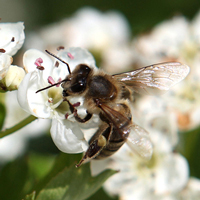
Bee Keepers Sue EPA
View the page for this story
A coalition of beekeepers and environmental organizations is suing the EPA to get tighter regulations for insecticides called neonicotinoids. The group argues the agricultural pesticides contribute to the dramatic decline in honeybee populations. Peter Jenkins, a lawyer for the Center for Food Safety, tells host Steve Curwood they pose risks for birds as well. (15:00)
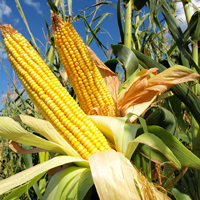
A Victory for GMOs
View the page for this story
The bill Congress recently passed to avoid a government shutdown contained a rider that helps companies that make genetically modified crops. The rider takes away the authority of federal courts to order GMO crops removed from sale and production if they are found to be harmful. Montana Democratic senator Jon Tester tells host Steve Curwood that the rider is arguably unconstitutional. (05:15)
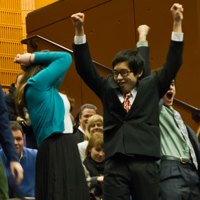
Power Shift - Glocal Challenge
/ Bobby BascombView the page for this story
500 students from across the US and Canada are competing in a challenge to find practical solutions to environmental problems in their community. Living on Earth’s Bobby Bascomb went to an awards competition for students in Cambridge, Massachusetts. (07:35)
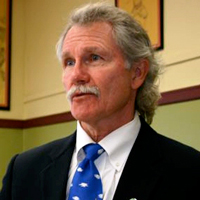
Coal Exports
View the page for this story
U.S. Coal companies want to build export facilities in the Pacific Northwest to ship coal to Asia. But the governors of Washington and Oregon are urging the White House to consider the impact on climate change and taxpayers before approving the projects. Amelia Templeton of the public radio collaborative EarthFix talks to host Steve Curwood. Then local business owners Richard and Tanya Burkholder explain why they favor of exporting coal as part of the Voices of Coal project. (07:30)
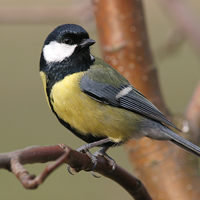
BIRDNOTE®/Urban Birds Change Their Tune
/ Michael SteinView the page for this story
With spring in the air, birds are singing loudly to attract mates and claim territory. As Michael Stein reports in today's BirdNote®, noisy human cities are forcing urban birds to change their tunes. (02:00)

Baby Polar Bear Rescue
View the page for this story
Climate Change is making life difficult for polar bears across the world. But an orphaned polar bear cub from Alaska is about to get a new home and a new sibling at the Buffalo Zoo in upstate New York. The President of the Buffalo Zoo, Donna Fernandes, tells host Steve Curwood all about the cuddly cubs. (07:40)
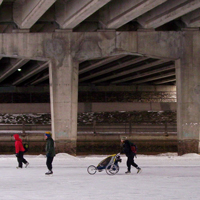
Hans Brinker with Briefcase
/ Bob CartyView the page for this story
In Ottawa the solution to a long commute is a slick one, don your skates and glide to work. For two and a half months of the year, a canal in the Canadian capital becomes one of the world's largest skating rinks, complete with on-ice cafes that serve up sizzling, hot beaver tails. Bob Carty has our story in this reporter's notebook. (06:50)
Show Credits and Funders
Show Transcript
HOST: Steve Curwood
GUESTS: Peter Jenkins, Jon Tester, Amelia Templeton, Donna Fernandes
REPORTERS: Helen Palmer, Bobby Bascomb, Michael Stein, Bob Carty
[THEME]
CURWOOD: From Public Radio International, this is Living on Earth. I'm Steve Curwood. Governors in the Pacific Northwest ask the President tough questions over the climate effects of plans to build ports and rail-lines to export coal to Asia.
TEMPLETON: Some environmental groups are now coming out and saying this is a bigger deal than Keystone. I know Greenpeace has done some accounting and they have identified these proposals taken collectively as one of the greatest climate decisions that this country will make.
CURWOOD: Also, high school students come up with novel solutions to environmental problems in their own communities.
STUDENTS: If not now then when? if not us who? If not here at CRLS then where? Because the world is in our hands.
[APPLAUSE]
CURWOOD: Plus, Buffalo zoo and its one, two cute – way too cute - polar bears. We'll have that and more this week on Living on Earth. Stick around.
[THEME]
[NEWSBREAK MUSIC: Boards Of Canada “Zoetrope” from “In A Beautiful Place Out In The Country” (Warp Records 2000)]
ANNOUNCER: Support for Living on Earth comes from Stonyfield Farm, makers of organic yogurt, smoothies and more.
Bee Keepers Sue EPA
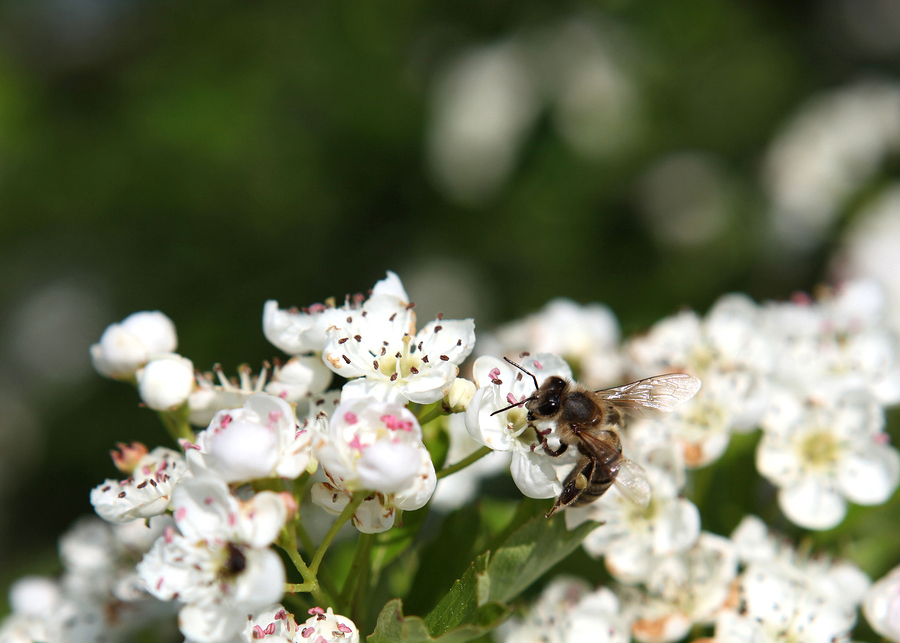
Bee on a flower (photo: Bigstockphoto.com)
CURWOOD: From the Jennifer and Ted Stanley Studios in Boston, this is Living on Earth. I’m Steve Curwood.
At last, the blush of spring is in the air. It’s been in the 60s in Denver, Kansas City and Nashville, and even in snow battered Boston the mercury is flirting with the 50s. Near our studio the crocuses are out, all orange and white and purple and the first daffodils are flashing a cheery yellow from sheltered spots. Time for our resident beekeeper, Helen Palmer, to check the hives.
PALMER: So I have 2 hives out on my back deck. I’ll need my hive tools and the brush. The first thing to do is take off the cover.
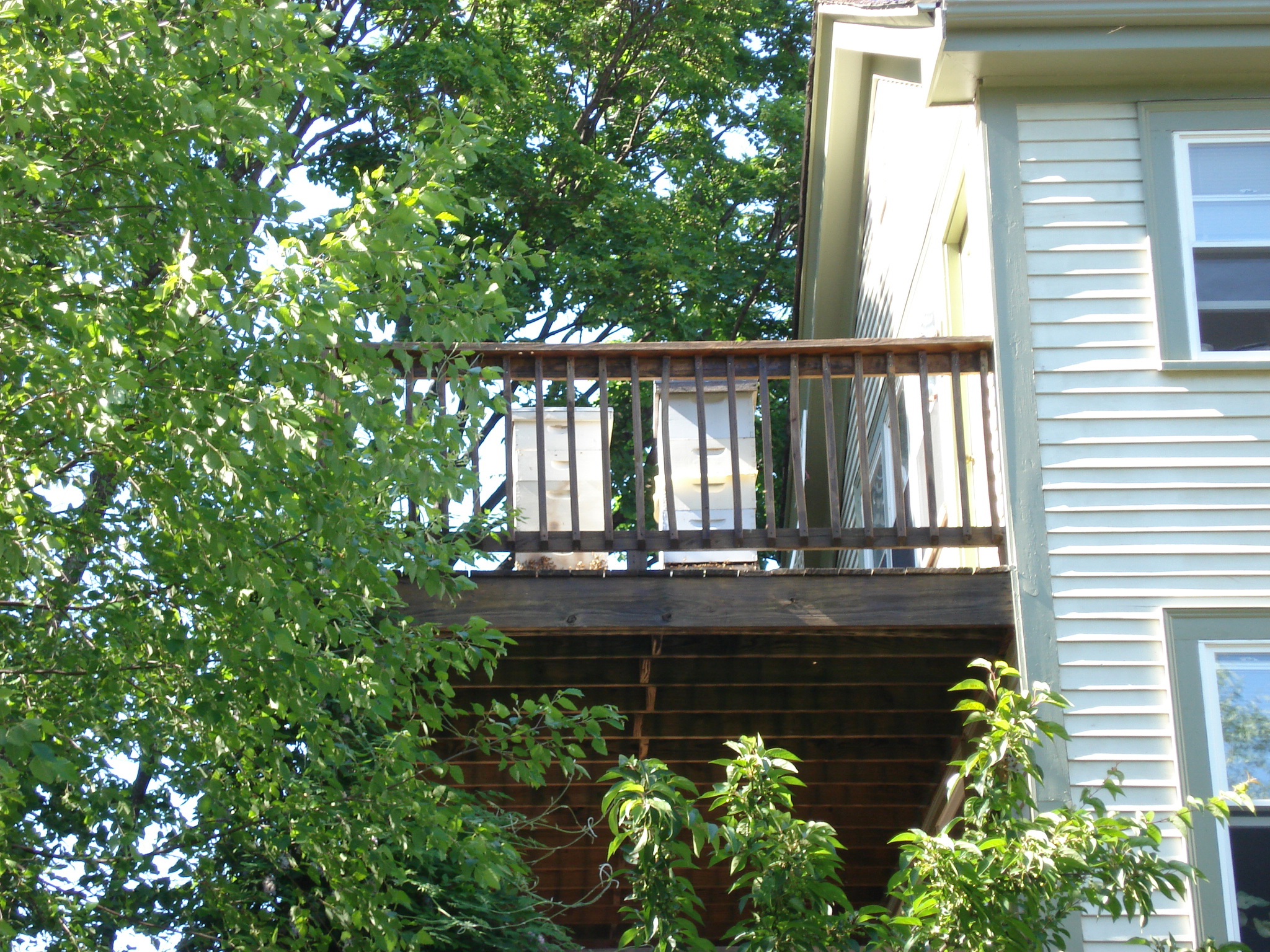
Some beekeepers, including Living on Earth's Helen Palmer, find their bees have not survived the cold winter. Helen Palmer's hives on her deck in the summer. (Photo: Helen Palmer)
[HEAVY COVER LIFTS]
PALMER: I’ve got a couple of supers on top here...just stack them up. Then you take the hive tool, which is a kind of thing to pry off the top insider cover with...so the inside cover. And now I’m down to what’s called the hive body, and I don’t...oh, I see dead bees. Many dead bees. Wonder why they died? I think it’s partly because it was so cold.
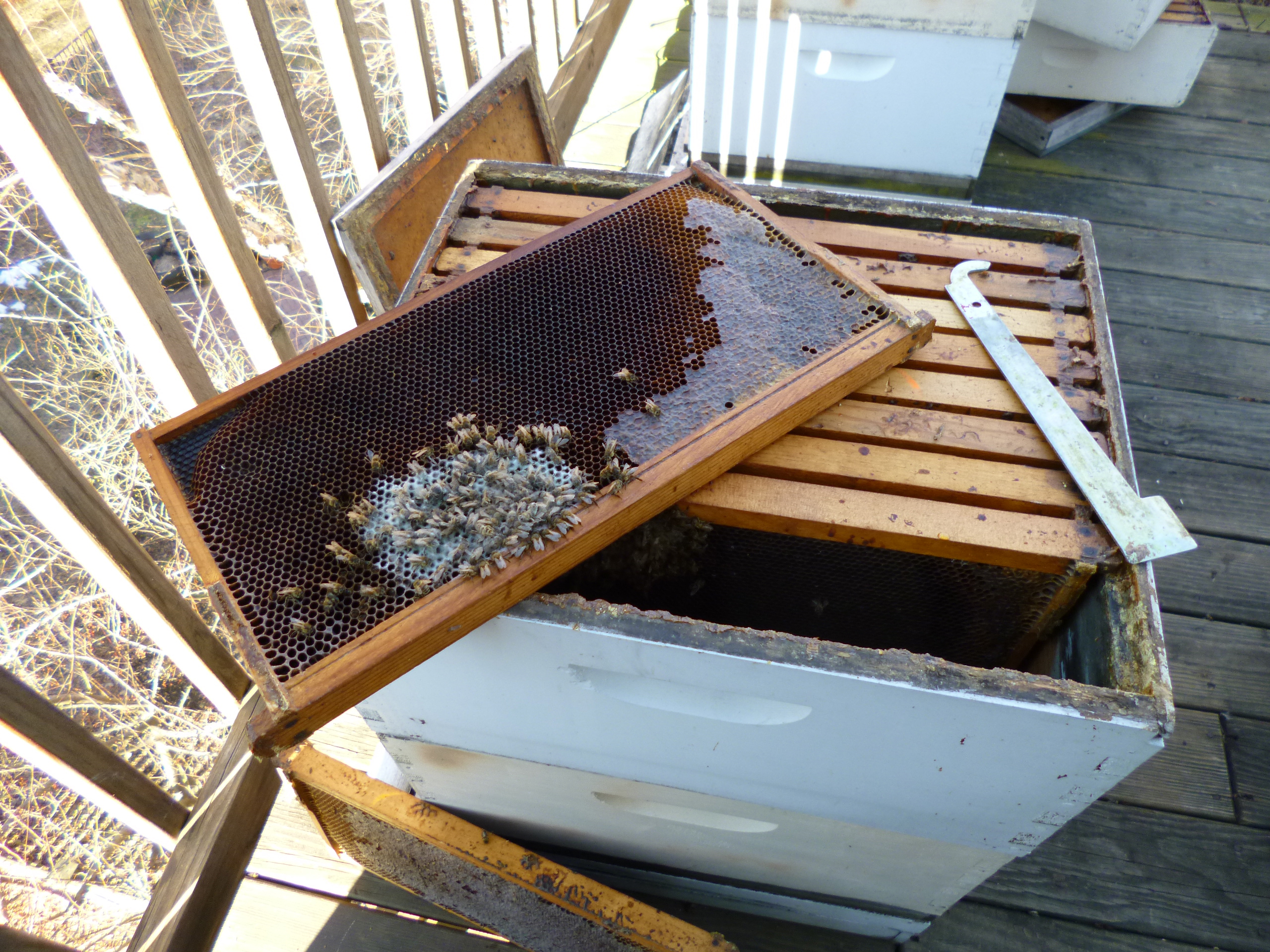
Dead bees and mold on a frame. (photo: Helen Palmer)
[BIRD CHIRPING, SOUNDS OF LIFTING OUT A FRAME]
PALMER: Now here’s the thing. This is a frame absolutely full of honey. So that means they didn’t die of hunger. And this next one here covered with bees and full of honey...ah, but I see mold. Mold is one thing that really does seem to affect them if it gets damp inside the hive. But there’s lots and lots and lots of honey. It isn’t a shortage of honey. I don’t know what they died of. So I have two hives full of dead bees. That's the most depressing thing.
CURWOOD: So what killed Helen’s bees this time? Prolonged cold can do it. And bees face other stressors - mites, mold, and diseases that experts think contribute to Colony Collapse Disorder that's emerged over the last seven years or so. A number of studies incriminate a relatively new class of pesticides called neonicotinoids, two of which got federal approval in the US in 2003.
These chemicals though have already been banned in some European countries, but the US Environmental Protection Agency declined last year to restrict their use here. So now a coalition of beekeepers and environmental advocates, including the Center for Food Safety, is suing the EPA. Peter Jenkins is a lawyer for the Center. He says birds as well as bees are at risk.
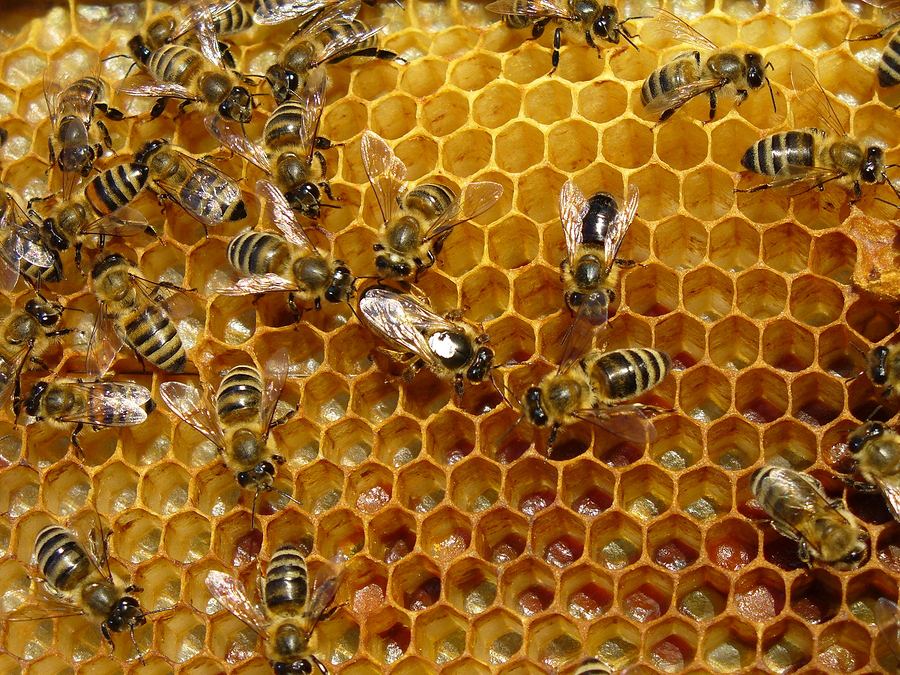
Bees on the honeycomb (photo: Bigstockphoto.com)
JENKINS: The estimates are that neonicotinoids are being used over 200 million acres of this country, which is...well, the country of Germany is 100 million acres. So 200 million acres...imagine two Germanys next to each other. But we actually know they’re used in hundreds of different products including household and garden products.
So we’re very concerned about them, mostly because they’re systemic products, meaning that they don’t just last for a short period of time after being sprayed or used. They are designed to be absorbed into the plant and become part of the plant and turn the plant into toxic plants as far as insects go. That’s their whole purpose. They’re insecticides.
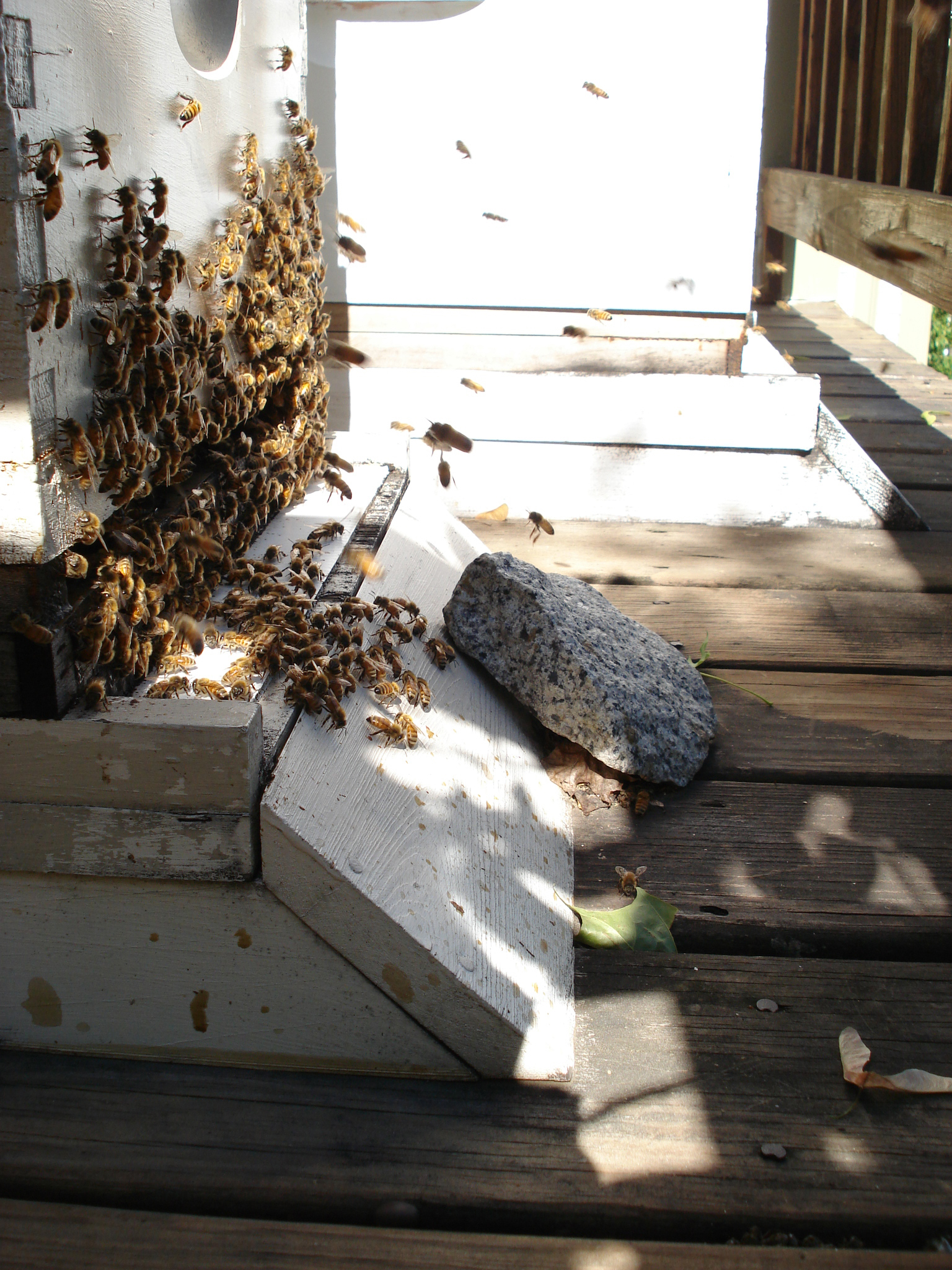
Bees clustered round the hive entrance in the summer. (photo: Helen Palmer))
CURWOOD: What proof is there that this class of chemicals, these neonicotinoids, are involved in the collapse of bee populations?
JENKINS: Well, it’s just been accumulating proof. Actually we think it’s been clear since the chemicals were first registered. EPA’s own scientists took a hard look at them internally and said these things are going to kill bees - we need detailed studies before approving them. And that was back in 2003.
But those scientists in the agency were overridden by apparently upper level managers who said, “Well, we think we can live with them, and we’ll allow them to go onto the market, we’ll allow the companies to do the studies after they’ve been approved and used across the country.” And that’s sort of what the lawsuit that we’re involved in is about.
CURWOOD: So as I understand it, your case has been brought with several environmental groups, as well as some professional beekeepers. You’re suing the EPA. What exactly do you want to see happen?
JENKINS: Well, we would ask a judge to look at three main problems that have come up. The first is this whole question of what I sort of alluded to, which is conditional registration, which is a process inside our insecticide and pesticide laws that allows EPA to approve these products conditionally; and the condition is that the company has to perform a number of studies that the EPA mandates as part of the approval.
And the problem is that while the EPA mandated that a lot of these conditions be met, it’s been 10 years - in some cases, 11 years - since those mandates were made part of the approvals and the company still has not come back with the studies showing these insecticides are safe. Some estimates are that two-thirds of approved pesticides have this conditional registration issue.
CURWOOD: And what else are you suing them about?
JENKINS: Well, another part of the suit is the Endangered Species Act. This gets into broader, beyond bees questions. We know these pesticides, neonicotinoids, not only impact bees; they impact whole ecosystems. They’re very persistent. They last for several years in cases. And they run off into surface water and they get into ground waters. We know they impact aquatic invertabrates; we know they’re impacting birds and other species as well.
We’re very concerned we may be looking at a second “Silent Spring” sort of scenerio where we’re just using pesticides and insecticides that are too good. They’re sterilizing whole ecosystems. And then we want to be sure to look at the indirect effects on birds, migratory birds, and all sorts of other species.
CURWOOD: As I understand, the European Union is talking about imposing a ban on the use of these chemicals.
JENKINS: That’s right. The Europeans have confronted these same sort of insecticides. As you can imagine, Bayer, the company that makes clothianidin and a lot of these products, is based in Germany, and ironically, Germany is one of these countries that has banned certain uses of these insecticides.
Other countries that have already banned them are Slovenia, France, Italy, Austria and Sweden - and that was several years ago. But then, just in the last year, it’s really come to a head in Europe because of some highly significant new studies that came from France and from England showing devastating impacts of these insecticides on bees and bumblebees.
CURWOOD: If the populations continue to decline, what kind of impact do you think it will have on food production here in the U.S.?
JENKINS: Great question. And it’s really come to a head just the last few months in California in the almond industry. I don’t think people realize, but almonds are California’s number one crop these days, and almonds are 100 percent dependent on honeybee pollination.
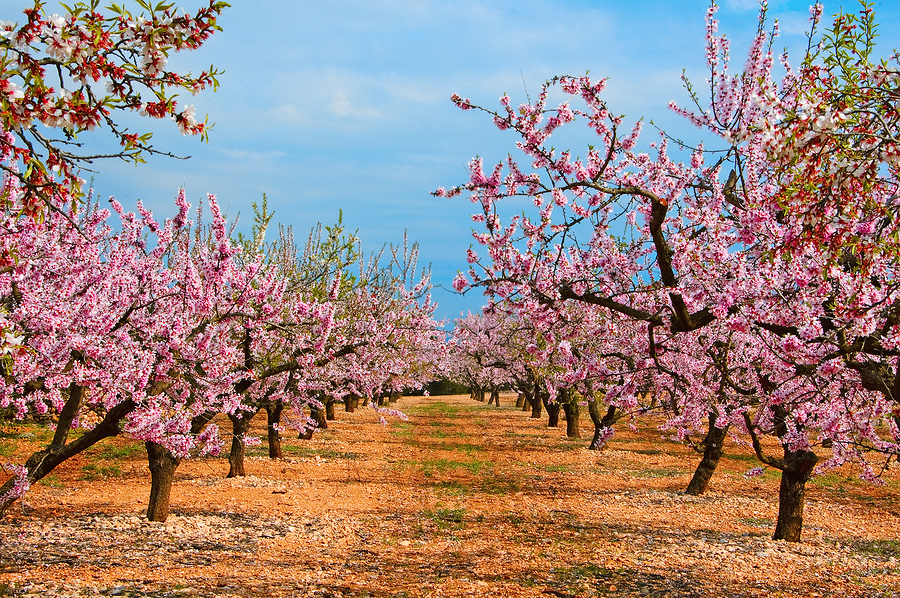
Almond trees are 100% dependent on bees for pollination. (Bigstockphoto.com)
This year has been the worst year for almond pollination in memory where they have just barely able to get enough bees, probably not able to get enough bees to...you know, the commercial migratory bee keepers come in, and they’re being offered huge amount of fees to pollinate these nuts compared to historical records, yet they still haven’t been able to produce enough. And I guess the proof will be in the pudding when the trees try to produce the nuts in a few months. But the reports back from the California almond industry are there’s been a real crisis of pollination.
And that could continue on because these same migratory bee keepers, some of them who are in our lawsuit then will go pollinate apples in Washington state and berries in Massachusetts and Maine...and they do a big circuit around the country pollinating. And if the bees are too weak to do it, then they just can’t meet the contracts.
CURWOOD: In 2012, there were several environmental organizations and beekeepers who petitioned the EPA to restrict the use of these chemicals. What’s different now? What kind of success do you expect out of this lawsuit?
JENKINS: Since we did our petition, there’s been really literally dozens of studies that have come out and all this regulatory action in Europe, and, of course, this continuing bee loss where this year the bee keepers are expected to lose up to 40 percent of their bees.
And then, on top of that, you get a report like the American Bird Conservancy saying look, this is not just about the bees, this is about ecosystems and birds and enviromental sustainability. So that’s really what I think makes the case very compelling and one of the reasons we went to sue.
CURWOOD: Peter Jenkins is a lawyer for the Center for Food Safety. Thank you so much for taking this time today.
JENKINS: Thank you. I appreciate it.
CURWOOD: Syngenta and Bayer, two of the makers of neonicotinoids, argue any harmful effects on bees are unproven and a ban would be costly, but other researchers say insect pollinators contribute close to $200 billion dollars to food production worldwide.
Related links:
- The 2003 EPA report recommending further review of neonicotinoids
- Center for Food Safety
A Victory for GMOs
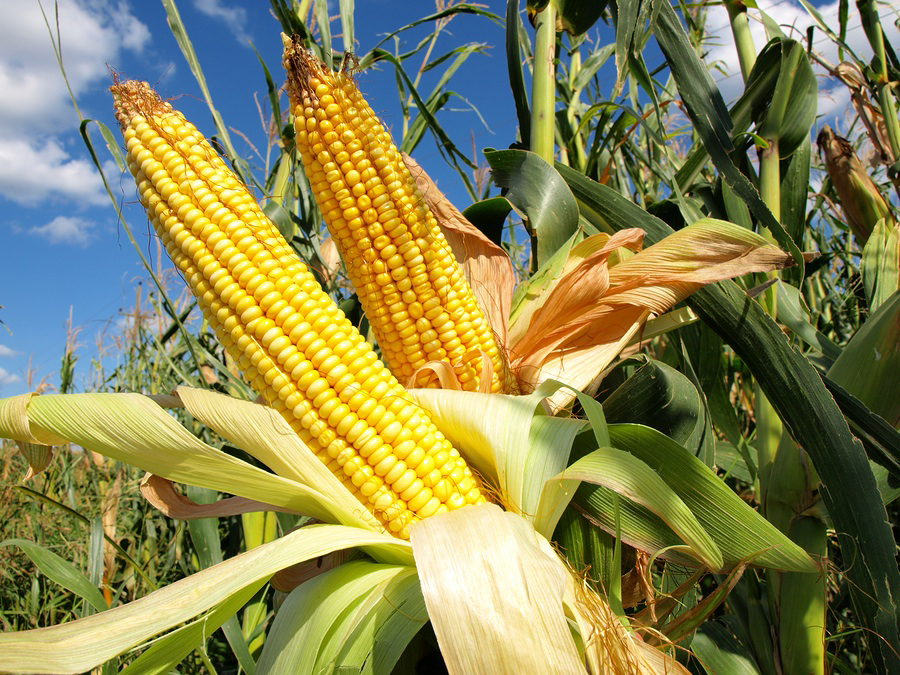
Roughly 80 percent of the corn grown in the United States is genetically modified. (Bigstockphoto.com)
CURWOOD: The food and agricultural biotechnology companies that develop genetically modified crops recently won a victory in the US Congress. In a last minute crush to enact a stop-gap Continuing Resolution to avoid a US government shutdown, a little known amendment or rider was tucked into the measure that keeps federal courts regulating the planting of GMO crops. Jon Tester, a farmer and the junior Democratic senator from Montana, tried and failed to remove the rider, and he joins me now to explain.
TESTER: It's a rider that if the USDA makes a mistake when it issues a permit to plant a genetically modified crop, they can’t go back and pull that crop out of the ecosystem, out of our land. If a court finds that, in this case the USDA, a federal agency, finds this crop is bad, is harmful, the USDA, because of this rider, is required not to comply with that court ruling. So its constitutionality is questionable at best.

Jon Tester is a Democratic senator from Montana. (Jon Tester)
The other problem that I had with this amendment, with this rider, is it was air-dropped in. We had not voted on this previously. And as you know, the Continuing Resolution was pretty darn important. It kept the government running. I don’t think anyone wanted to see a government shutdown. So we were told if this provision was pulled out, the House would not pass it, that the government would shut down.
CURWOOD: Now as I understand it, Senator, there’s no member of the House that has taken responsibility for adding this rider, this provision. Why is the author so reluctant to step forward do you think?
TESTER: I don’t know. They ought to. But this is the kind of stuff in government...not only is it not good government, not only is it not what we’re supposed to be doing in Washington, DC, but it doesn’t give people the opportunity to have their voices heard and at least have a vote on issues. I mean, I would have loved to have had a vote on my amendment to pull this stuff out.
Look, I voted against cloture, I voted against the bill, and it wasn’t because I didn’t think there were good things in the bill...there were some really good things in the Continuing Resolution. But this was such a poison pill for me, being somebody that’s in production and agriculture, somebody that’s been connected with the land.
My grandfather homesteaded the land that I farm so we’ve been connected for a long time. And plus it just went against our branches of government where we have checks and balances that we were told specifically because of this rider to ignore those checks and balances that are in our governmental system, in our democracy.
CURWOOD: Tell me, how long does this rider live as law? Does it go away when the Continuing Resolution expires in six months? Or does America live with this legislation from now on?
TESTER: There’s some debate on that. But I believe it goes away in September. There’s a lot of things that can be done between now and September, this being our growing season here in North America.
CURWOOD: Now as I understand it, the food and agriculture biotech companies have spent more than half a billion dollars lobbying with campaign contributions over this past decade or so. Do you think that kind of money, campaign contributions to members of Congress and that kind of lobbying, do you think that’s a factor here?
TESTER: Well, it could be. I’m sure...you know, I just came through one of the toughest Senate races in the country here in Montana. And I’m sure they probably spent a lot of money on me. We don’t know because that money is secret.
CURWOOD: They spent it on you...or against you?
TESTER: Oh, I’m sure they spent it against me. But I don’t know that. So that’s probably an unfair claim because all that money is secret. But my guess is that they understand where I stand on these issues. And quite frankly, from a farmer, I don’t want to see our seed controlled by some huge multinational company.
Farmers have control over the land. Their markets are consolidated. Their input costs go through the roof because there’s a few that offer that up and now we’re going to give our seed supply to a multinational company? That doesn’t make any sense to me, and I think this is the direction that things are headed. And that’s why I’m very concerned about it also.
CURWOOD: So, you run an organic farm there in Montana on the land that your grandparents homesteaded originally. Tell me, how does your experience as a farmer inform your opinion of the use of genetically modified organisms for crops?
TESTER: I would just say this; Mother Nature is a great thing. She’s given us so many things to feed people with. And when man steps in and thinks we’re smarter than Mother Nature, I have never found that to be the truth.
CURWOOD: You’re saying Mother Nature bats last.
TESTER: Absolutely, though my experience. And we’ve only been on the farm about 35 years. But through my experience, Mother Nature always wins, and if you can work with her, you’re much better off. In this particular case, I think man is introducing crops into the ecosystem that they have no idea what the long term impacts are going to be.
You combine that with the fact that now we have no review because of this rider, and we can’t pull back if we know there’s a mistake, you combine that with the fact I think there’s a concerted effort to get the seed in the control of the hands of few, and that’s a big deal if you’re in agriculture. I just think we need to walk slowly on this issue and make sure we know what we’re doing before we enter into it. This rider really goes against all of that.
CURWOOD: Jon Tester is the junior Democratic senator from Montana. Thank you so much, Senator.
TESTER: Thank you very much. It's a pleasure.
CURWOOD: There is more about GMOs, neonicotinoids, birds and bees on our website, LOE.org.
Related links:
- Jon Tester’s Website
- Text of HR.933, the Continuing Resolution
[MUSIC: Meshell Ndegeocello “Four Women” from Pour Une Ame Souveraine: A Dedication To Nina Simone (Naïve Records 2012)]
CURWOOD: Coming up...think global and act local, and win a free trip to Costa Rica. A high school challenge is just ahead Living on Earth.
Power Shift - Glocal Challenge
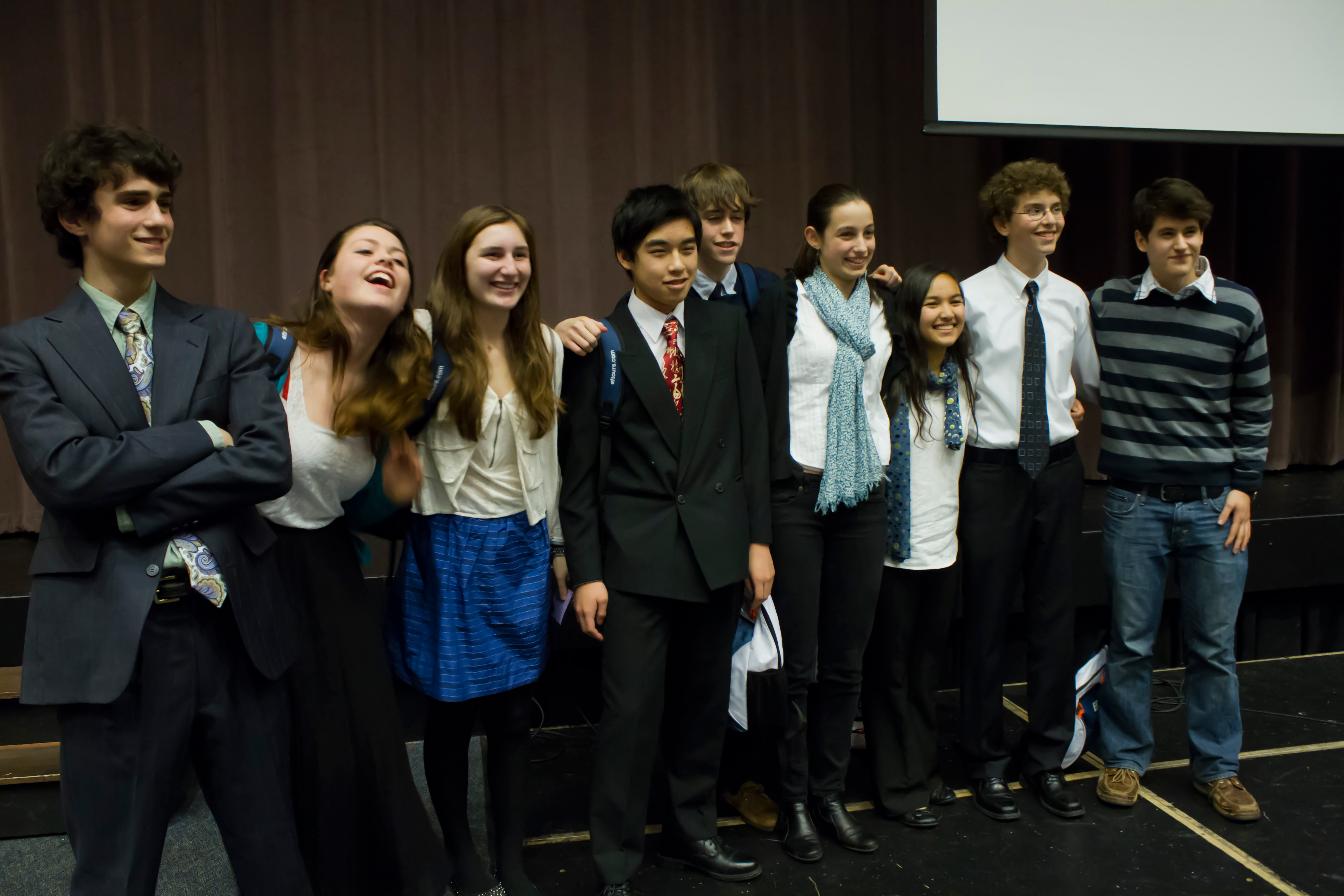
Glocal Challenge winners (from left to right) Josh Brancazio, Isabel Gray, Aida Muratoglu, Eric Chan, Ben Austin, Clio Macrakis, Anisha Nakagawa, Zachary Spitz and Octavio Chiesa celebrate after winning free trips to Costa Rica for the EF Global Student Leaders Summit in April. Missing from the photo is student winner Griffin Andreas. (photo: EF Education First)
CURWOOD: It’s Living on Earth, I'm Steve Curwood. More than 500 high school students from across North America have taken up the challenge to find practical solutions to ecological problems in their communities.
Participants get to go to the Global Student Leaders Summit in Costa Rica and get to meet Al Gore. Living on Earth’s Bobby Bascomb checked out what's called the "Glocal Competition" at Cambridge Rindge and Latin School in Massachusetts.
[RHYTHMIC STEPS]
BASCOMB: The high energy high school step team entertains an audience of students, teachers, and parents as they take their seats. Two student MCs, Julia Leonardos and Callum Nelson ham it up for the crowd.
LEONARDOS: Callum, did you come up with an environmental issue?
NELSON: Well, yeah my team did, but you gotta keep it a secret, OK?
LEONARDOS: Alright.
NELSON: They’re cutting down the rainforest, don’t tell anyone alright?
[AUDIENCE LAUGHS]
NESLON: We’re going to solve the problem.
BASCOMB: Of course, since there are no rainforests in Cambridge, Massachusetts, that project wouldn’t qualify. The challenge for these high schoolers was to identify an environmental problem in their community and find realistic, actionable solutions. The students just had one month to research a problem, find solutions, and present the idea to their teachers, peers, and a panel of judges.
LEONARDOS: Today we’re here to announce the final four finalists who will present to you today, right now, and then we’ll announce the two winners who get a trip to Costa Rica.
NELSON: What? Do we get to go?
LEONARDOS: I don’t think so.
NELSON: Alright, well anyways...
BASCOMB: The students took on a range of environmental issues from wasting electricity to recycling school milk containers. Chris Desnoyers is a member of a team called the Invasive Rangers. They examined the problem of invasive species like purple loosetrife and water chestnuts.
DESNOYERS: So here in Massachusetts the Department of Conservation and Recreation has a $10 million dollar budget for combating these invasive species; however this isn’t enough to eradicate them. They’ve been combating pepperweed, a salt marsh invasive. This has taken 2,000 volunteer hours in the last year just to get it somewhat under control, and a full third of these are spent mapping the plant before they can even try and get out to remove it.
BASCOMB: Their solution is to create an education campaign for citizen scientists to take photos of invasives and tag them using existing map technology. It would free up government scientists to do work that requires more skill or training.

The Cambridge Rindge and Latin team the Invasive Rangers. (photo: EF Education First)
Another student group calls themselves the EPA, Environmental Paper Assault. They’re concerned with how much paper their school uses in a year.
STUDENT: Every day, the CRLS copy center uses about 28,800 sheets of paper. The annual paper usage would stack to 1,867 feet, several hundred feet taller than the Empire State building. In total, we are on track to use 5.6 million sheets of paper this year.
BASCOMB: Instead of paper, they suggest investing in inexpensive laptops so students would no longer need paper hand-outs from teachers. All the teams had to canvass the community to get support for their plans. The Environmental Paper Assault wraps up their pitch with a direct appeal to school officials.
STUDENTS: If not now, then when? If not us, who? If not here at CRLS, then where? Because the world is in our hands.
[AUDIENCE APPLAUDS]
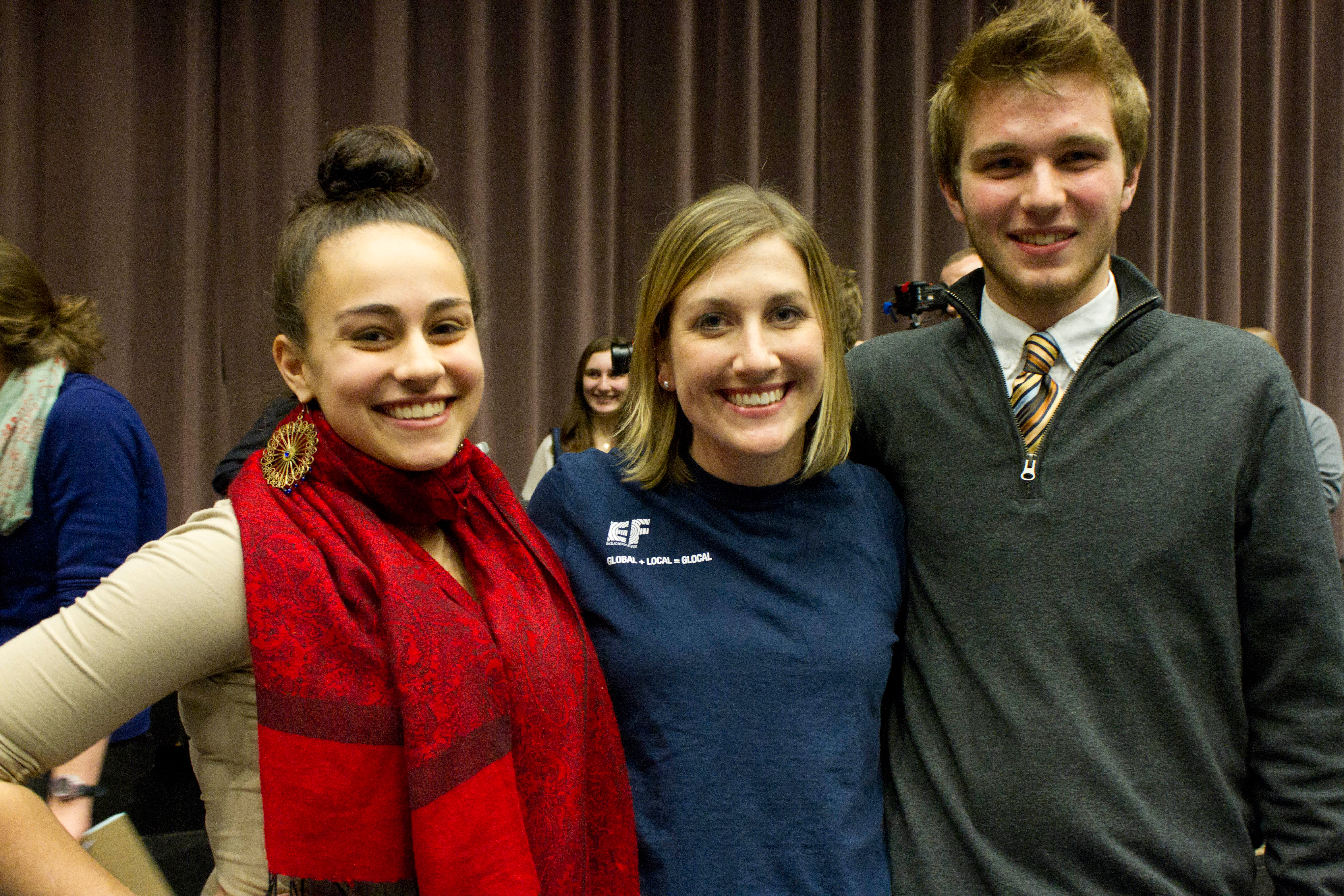
CRLS Student MCs Julia Leonardos (left) and Callum Nelson (right) (photo: EF Education First)
[SCHOOL A CAPPELLA GROUP PERFORMS SONG]
BASCOMB: The school a cappella group performs for the crowd while judges decide on the two winning teams who will get a free trip to Costa Rica.
[SINGING CONTINUES]
BASCOMB: Altogether, 500 students from across the US and Canada submitted projects on line. One group, from West Potomac High School in Alexandria, Virginia, is worried about pollution running into the Potomac River. Max Leonard is a senior.
LEONARD: I row crew and from experience I know that the water can get very oily on top. It’s not always safe to swim in all the time, especially if you have cuts because they can be very easily infected. So, I know that this impacts a lot of people around it. So I think it would be nice for us to make the river cleaner.
BASCOMB: Much of the pollution is caused by run-off from parks and golf courses, so the students plan to build buffers to keep it out of the river. Lee Orleans is another member of the team.
ORLEANS: We want to build up a bidi buffer is what we’re calling it, which is our take on a riparian buffer. And we’re going to make them smaller so they fit in our area and we can make more of them and they’re more cost effective than a large buffer but hopefully they’ll have the same effect.
BASCOMB: The “Glocal Challenge” was created by the for-profit organization EF Education First. Their mission is to facilitate student learning through travel abroad. Kate Burseth, the executive vice-president of EF Education First, says she’s surprised by the response she has seen from the students participating in the challenge.
BURSETH: It’s interesting. I thought the draw would be a trip to Costa Rica and I think the draw is very much a chance to have their voices heard and a chance to come up with creative solutions to challenges that they see. And a way for them to have an impact on making the world a better place, and sort of figuring out how they can have a mark on the world they’re inheriting.
BASCOMB: That’s certainly what Cambridge student Andreas Hoffman feels. He’s a member of a team that calls themselves the Swagger Ducks.
HOFFMAN: The environment is the place where we’re going to grow up and live out the rest of our lives. So, it’s important not only for the present, like the baby boom generation, but it’s really important for us because we’re the ones that are going to be inheriting this planet and we need to make sure it’s a nice place to live.
[CROWD TALKING]
BASCOMB: When the judges at the Cambridge high school finish their deliberations, the MCs announce the winners.
LEONARDOS: Our first winner receiving a free trip to Costa Rica...
NELSON: Is…EPA, Environmental Paper Assault.
[AUDIENCE CHEERS]
LEONARDOS: Alright so there is one more winner.
NELSON: Drum roll please.
LEONARDOS: The second winner of a free trip to Costa Rica is… Environmental Action Club.

CRLS Students hear their team name announced and know they have a chance to win a free trip to Costa Rica. (photo: EF Education First)
[APPLAUSE]
BASCOMB: Aida Muratoglu is a freshman and a member of the second winning team, which is an existing environmental club at the school. They want to work with the city of Cambridge to invest in green roofs and walls to reduce the urban heat island effect.
MURATOGLU: We were actually planning on continuing our project if we won or not. So, I’ve actually been into these environmental issues my whole life really, so, it’s just a next step.
BASCOMB: Why are you interested in the environment?
MURATOGLU: It’s, like, our world! It’s everything we know, it’s everything we are. The fact that it’s dying, that it’s going away on us is really important to me. It affects our everyday life in ways that we don’t realize. So, I think it’s a very very important thing to be environmentally active.
BASCOMB: And around Earth Day all these environmentally active students will get the chance to meet Al Gore, see some wildlife, and soak up some sun in Costa Rica. For Living on Earth, I’m Bobby Bascomb.
Related links:
- Education First
- Glocal Challenge video
[MUSIC: Snowboy “Jazzakuti” from The Many Faces Of Snowboy (Acid Jazz Records 1996)]
Coal Exports
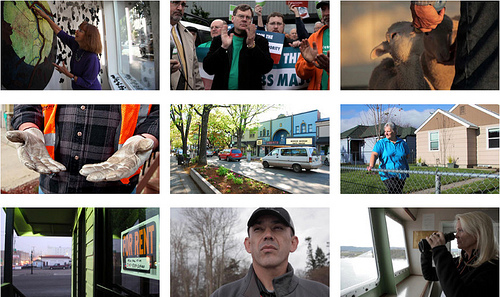
EarthFix's "Voices of Coal" project brings together diverse perspectives on the coal export debate in the Northwest. (photo: EarthFix)
CURWOOD: The governors of Oregon and Washington State are asking President Obama’s environmental team to weigh in on controversial plans to export coal from federal lands in Montana and Wyoming to markets in Asia. Governors John Kitzhaber of Oregon and Jay Inslee of Washington, both Democrats, have sent a letter to the White House, asking the government to consider costs to the climate and taxpayers as it reviews plans to build port facilities and rail lines.
Amelia Templeton from Oregon Public Broadcasting and the public radio collaborative EarthFix has been reporting on this story and joins us now to discuss the governors’ letter. Hi there, Amelia, how are you?
TEMPLETON: I'm good. How are you?
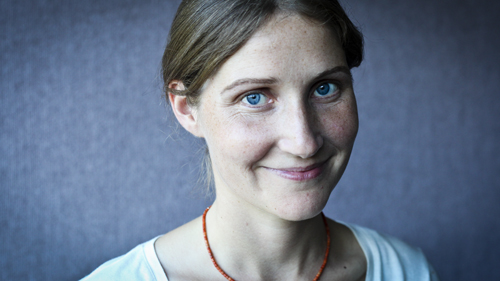
Amelia Templeton of Oregon Public Broadcasting (photo: Amelia Templeton)
CURWOOD: Glad to have you on the program! So to be clear, the governors of Washington state and Oregon are not asking to block the export of coal from federal land. They’re simply raising questions?
TEMPLETON: Yes, I think that's right. I mean, they're bluntly not in a position to block the export of coal from federal lands. But they're asking for: first, careful accounting of how much the government charges coal companies for the coal that we sell off of federal lands.
They’re asking for a clear accounting of the climate change consequences of choosing to export this coal and building the infrastructure that will make that happen. And they’re kind of warning the federal government. They essentially say these decisions will dwarf any other decisions we make regarding climate change, and it will be very difficult to credibly go to the international community and say that we are fighting climate change while continuing to make federal coal available this way.
CURWOOD: So the governors are saying that the resulting carbon dioxide, that is global warming emissions, from these coal exports would amount to some 240 million tons per year. How accurate do you think that assessment of some 240 million times a year might be?
TEMPLETON: It's a little hard to say. We put that question to an expert. He came up with about 175 million tons a year, so a little lower than the governors’ estimate. Greenpeace has come up with its own estimate - a little higher - 280 million tons a year.
But just to put all those numbers in perspective - that's greater than the total admissions of Oregon and Washington combined for a year. So they're all pretty big numbers. They’re all very significant emissions. And right now the Council on Environmental Quality recommends that any projects with greater direct emissions than 25,000 tons of carbon dioxide a year should be looked at for its climate impacts. So it’s about 1,000 times the threshold of what should trigger this kind of review.
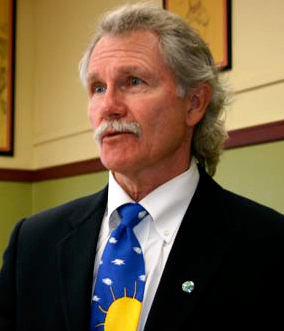
Governor John Kitzhaber of Oregon (photo: Orna Izakson)
CURWOOD: There’s a lot of talk about Keystone. Is this a bigger deal than Keystone do you think?
TEMPLETON: Some environmental groups are now coming out and saying this is a bigger deal than Keystone. I know Greenpeace has done some accounting and they have identified these proposals taken collectively as one of the greatest climate decisions that this country will make. So that’s certainly...Kitzhaber and Inslee aren’t the only people to have come to that conclusion.
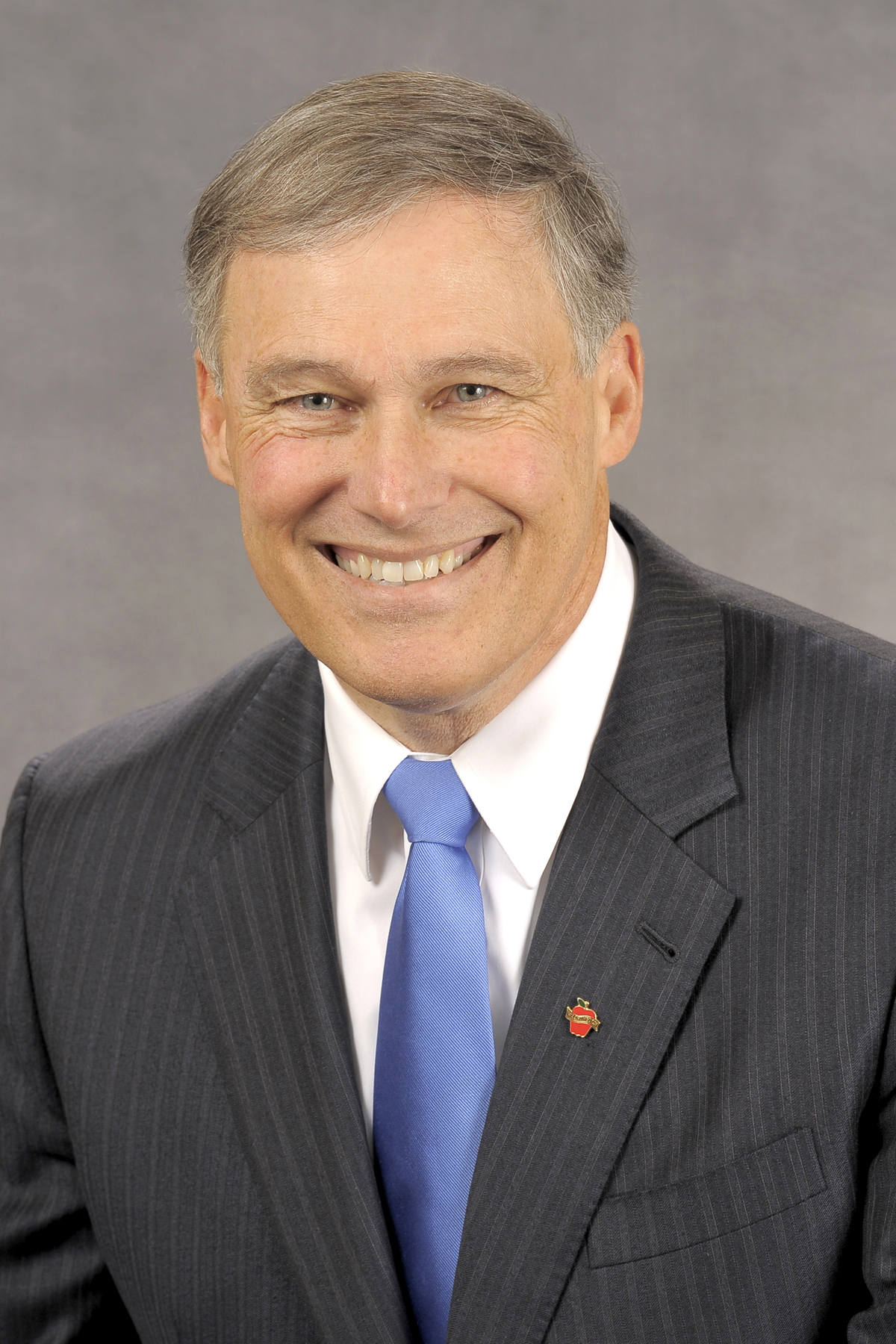
Governor Jay Inslee of Washington State (photo: the State of Washington)
CURWOOD: The letter claims that the way things are now structured, the US would actually be subsidizing the export of coal to Asia. Is that a fair assessment of what they're saying...and is that a fair assessment of the situation?
TEMPLETON: I think it’s definitely a fair assessment of what they're saying. The governors explain that the federal government owns some of the largest coal reserves in the world, and they allege that the federal government may be pricing that coal too low, and that if we do export that coal that will translate into a subsidy for coal-fired power generation in Asia.
CURWOOD: How much of an influence do you think the governors could have on these issues?
TEMPLETON: I don't know. I think what we've seen is they've been very influential in shining a light on the potential climate impacts of these terminals. And I think they’ve certainly been influential in encouraging debates. I'm not sure how how much influence they have over the ultimate permitting decisions that really rest of the Army Corps of Engineers and the federal government.
CURWOOD: How much do you think that this letter from these two governors reflects the concerns Washington and Oregon residents?
TEMPLETON: I think Washington and Oregon residents are certainly concerned about climate change and we have seen just in the last year some really massive forest and range fires that have a lot of people concerned. One prediction for our region is that changing climate may increase the size and frequency of wildfire.
We have major concerns with dams and water storage in the region that will be impacted by climate change. On the flip side though, polls have shown pretty significant support for these coal export proposals and pretty significant support on the basis of the jobs they’ll create and the economic activity they’ll bring to our region.
CURWOOD: Amelia Templeton is a journalist with Oregon Public Broadcasting and the Public Radio Collaborative EarthFix. She’s based in Medford, Oregon. Thank you so much, Amelia, for taking this time.
TEMPLETON: Thank you.
CURWOOD: EarthFix has been gathering public opinions on both sides of the fierce debate about the export plans for their Voices of Coal project. Here are a couple of those voices.
BURKHOLDER 1: I'm Richard Burkholder and I'm one of the owners at SpinReal Dunebuggy.
BURKHOLDER 2: Hi, my name is Tanya Burkholder. I’m also an owner at SpinReal Dunebuggy in North Bend, Oregon, just south of Lakeside. Our house is right here next to our business and the train tracks run probably 100 feet maybe behind our house. So we hear the train...
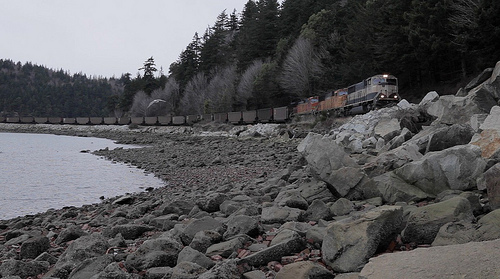
A coal train travels along Puget Sound en route to an existing coal export terminal near Vancouver, B.C. There are now 5 coal export terminals under consideration in Washington and Oregon to move coal from the Powder River Basin to Asia. (photo: Katie Campbell/EarthFix))
[TRAIN COMING DOWN TRACKS]
BURKHOLDER 1: They’ve always had a commercial type of train come through, whether it’s logging or it’s gravel, dirt. With the coal train coming through that they’re wanting to do, it’s just another product.
We have over 60 miles of these dunes along the coast. We have a wide variety of wildlife. There’s residential areas, there’s play areas. They train Iditarod dogs here, they do all types of stuff in the dunes. A coal terminal is not going to affect tourism.
We’re still going to see the business, we’re going to see the people coming through. It’s not in a position where we’re going to hurt the dunes. It’s not in a position where I believe it’s going to hurt the environment. It will impact our business as far as if the community grows, and economically it’s strong and sound. More people are going to come in here.
BURKHOLDER 2: It's a tourism driven community really. I think it would be nice to have an additional revenue booster in this area. I am from Montrose, which is in western Colorado right the middle of a lot of coal. A lot! To me growing up there it was just a part of life. There was a lot of people that my family knew that had jobs that were related to the coal industry. I saw coal trains a lot, but I really don't think there's a lot of negative about it. I think there's probably more positive. And I think that having it here would be a positive thing for this community.
BURKHOLDER 1: The terminal is going to provide jobs. It’ll bring in ships. It brings in sailors on those ships who spend money in town. They walk the boardwalk. They go to the restaurants. You drive down through Coos Bay right now. Look at how many buildings are empty. Look at how many businesses that used to be there are empty. With a coal terminal, put aside the coal. It’s business.
CURWOOD: Richard and Tonya Burkholder from Earth Fix’s Voices of Coal project. There’s a link our website, LOE.org.
Related links:
- Earthfix website
- Amelia Templeton’s reporter page
- Voices of Coal webpage
- Letter from Governor Kitzhaber and Governor Inslee
[MUSIC: BIRD NOTE® THEME]
BIRDNOTE®/Urban Birds Change Their Tune
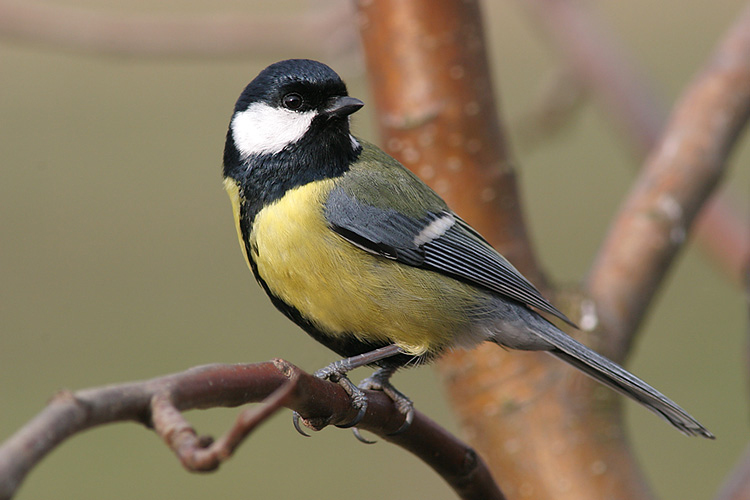
Great Tit (photograph: Antje Schulte)
CURWOOD: Well, in my garden in New Hampshire, the robins and woodpeckers and Cardinals are out and about, singing fit to beat the band, as they seek mates, claim and defend territory. But have some sympathy for birds that live in cities...our human cacophony is forcing them to change their tunes. Michael Stein has today's BirdNote®.
[BIRD CHIRPING ANIMATEDLY]
STEIN: This is the song of a Great Tit, one of the most familiar sounds of the European spring. The Great Tit, a relative of our chickadee, is common in the forests of Europe. Its song is more varied than the simple whistles of our chickadees.
Great Tits are also common in city gardens, where the sounds of the city
[CARS WHIZZING BY] can make the soft whistles of songbirds hard to hear. As a consequence, Great Tits in London, Paris, and Berlin have modified their behavior. They now sing at a higher pitch and faster than normal. One way they do this is to drop the lower-pitched notes from their song. Such a song carries better over the traffic noise of the city. And a bird that has shifted to a higher range is better able to declare its territory and attract a mate. Urban songs are also faster, probably so they can be repeated more often.
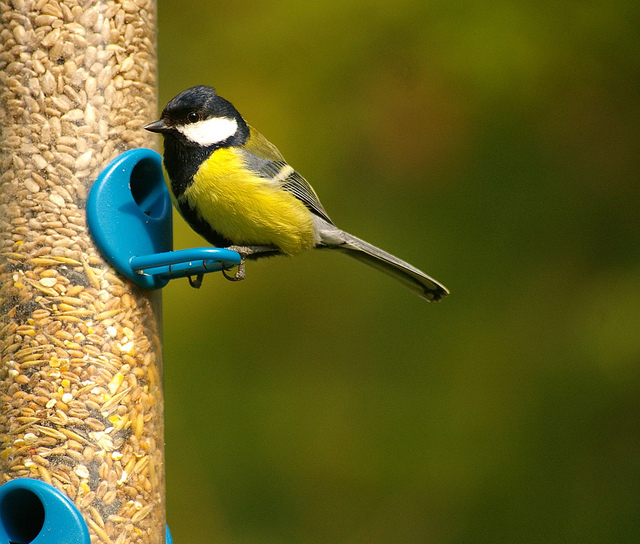
Great Tit at a city bird feeder. (photograph: Jean Mottershead)
Let’s listen to a forest bird [LOWER PITCH], and now its city cousin [HIGHER PITCH].
Once again, the forest bird [LOWER PITCH]. And now the city bird [HIGHER PITCH]. I’m Michael Stein.
CURWOOD: Check out some photos of garden birds at our website LOE.org.
[Written by Dennis Paulson
First two songs of the Great Tit and ambient European garden recorded by Martyn Stewart, naturesound.org
Urban / Forest Great Tit (“E” and “F”) comparison songs recorded by Hans Slabbekoorn: Leiden University, Netherlands.
Producer: John Kessler
Executive Producer: Chris Peterson
© 2013 Tune In to Nature.or March 2013 Narrator: Michael Stein]
Related links:
- Birdnote® website
- This story on the Birdnote® website
[MUSIC: John McLaughlin “Hearts And Flowers” from My Goals beyond (Polydor Records 1970)]
Coming up...how Buffalo is cuddling up to Polar Bear Cubs. That's just ahead here on Living on Earth.
ANNOUNCER: Funding for Living on Earth comes from the Grantham Foundation for the protection of the environment, supporting strategic communications and collaboration in solving the world’s most pressing environmental problems. The Kendeda Fund, furthering the values that contribute to a healthy planet, and Gilman Ordway, for coverage of conservation and environmental change. This is PRI, Public Radio International.
[CUTAWAY MUSIC: Greyboy All-Stars: “Multiplier” from Inland Emperor (Knowledge Room Records 2013)]
Baby Polar Bear Rescue

Luna in the snow (photo: Buffalo Zoo/Kelly Brown)
CURWOOD: It's Living On Earth, I'm Steve Curwood. Let's face it - baby polar bears are among the world's most adorable animals. So white and soft and cuddly. Of course, they don't stay like that, but Buffalo Zoo is about to have cute in duplicate.
The one lovable bundle of fuzz that they've been bottle-feeding has proved an irresistible draw since she went on show - and soon they'll have a second cub. Donna Fernandes is President of the Buffalo Zoo. Welcome to Living on Earth, Donna.
FERNANDES: Hello!
CURWOOD: So you're raising one cub - and you're about to have two. How come?
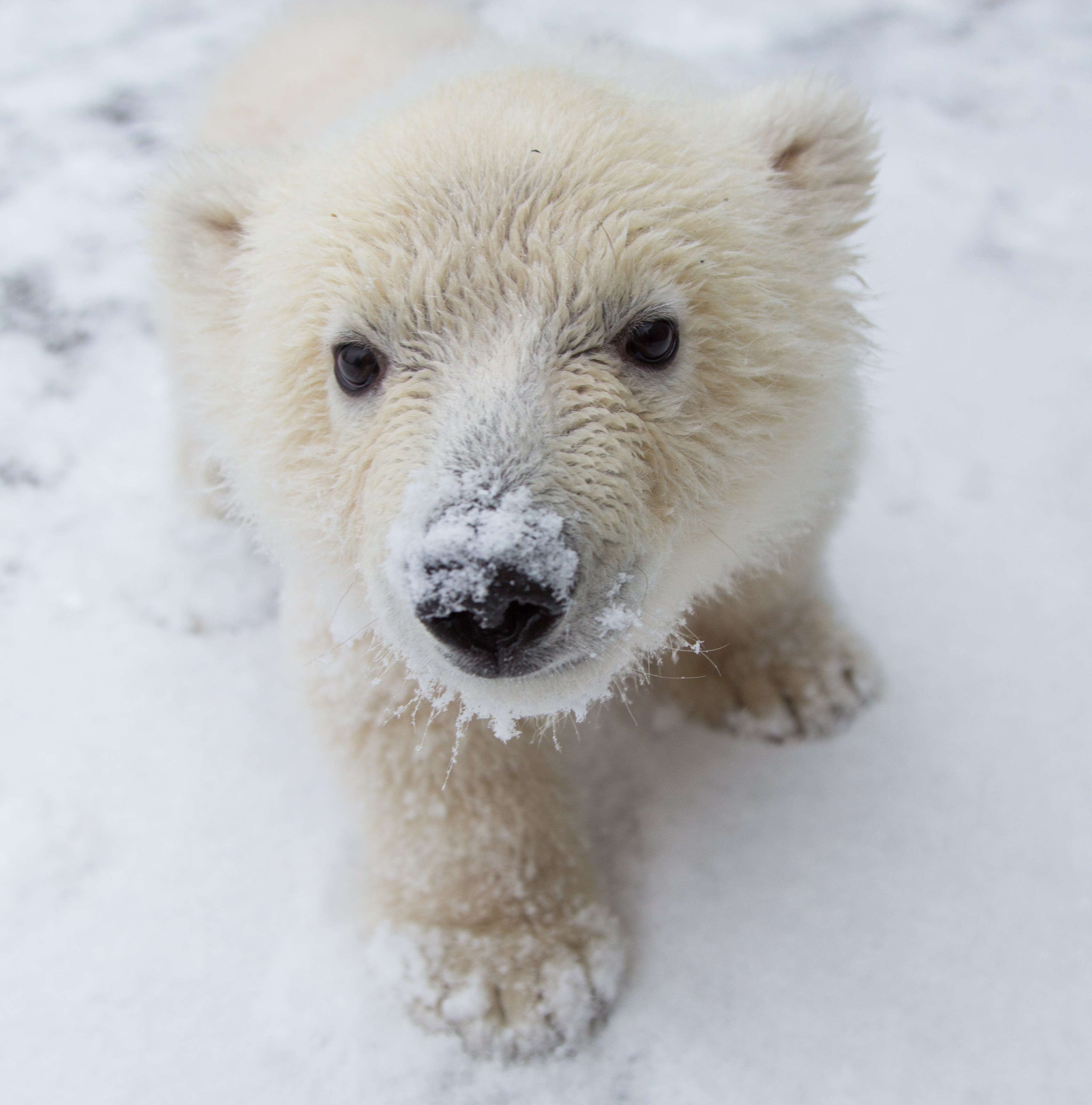
Luna the polar bear cub at the Buffalo Zoo (photo: Kelly Brown/Buffalo Zoo)
FERNANDES: Well, we are hand-rearing our female cub - nicknamed Luna because she was born on a full moon - because her mother was showing some inappropriate maternal behaviors and we didn't want to risk something happening to the cub. First time mothers often don't know what to do. Something plops out of you and “oh my God, what’s that, what am I supposed to do?” That happens in wild populations as well as captive populations.
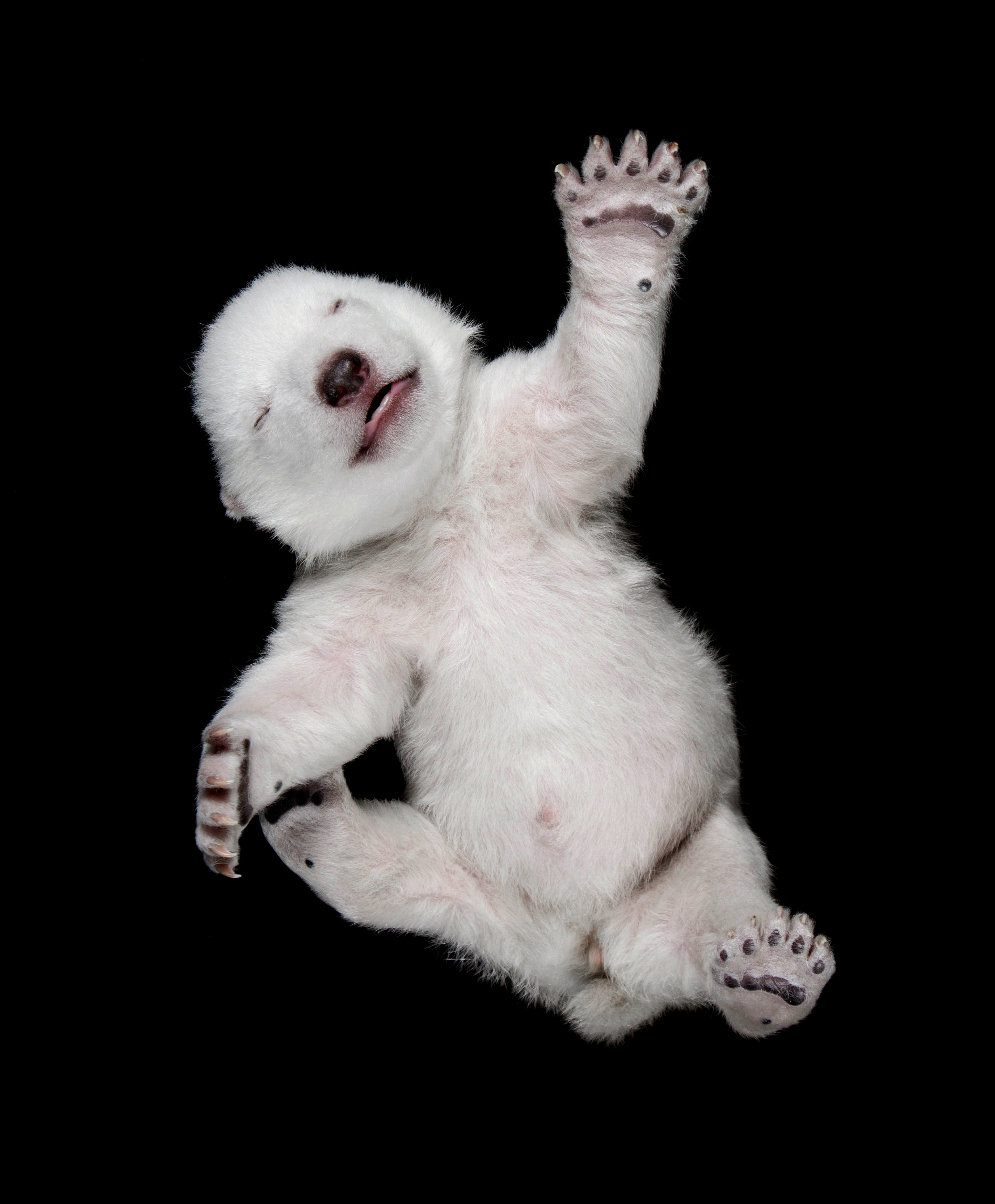
Luna at 1 month old. (photo: Buffalo Zoo/Kelly Brown)
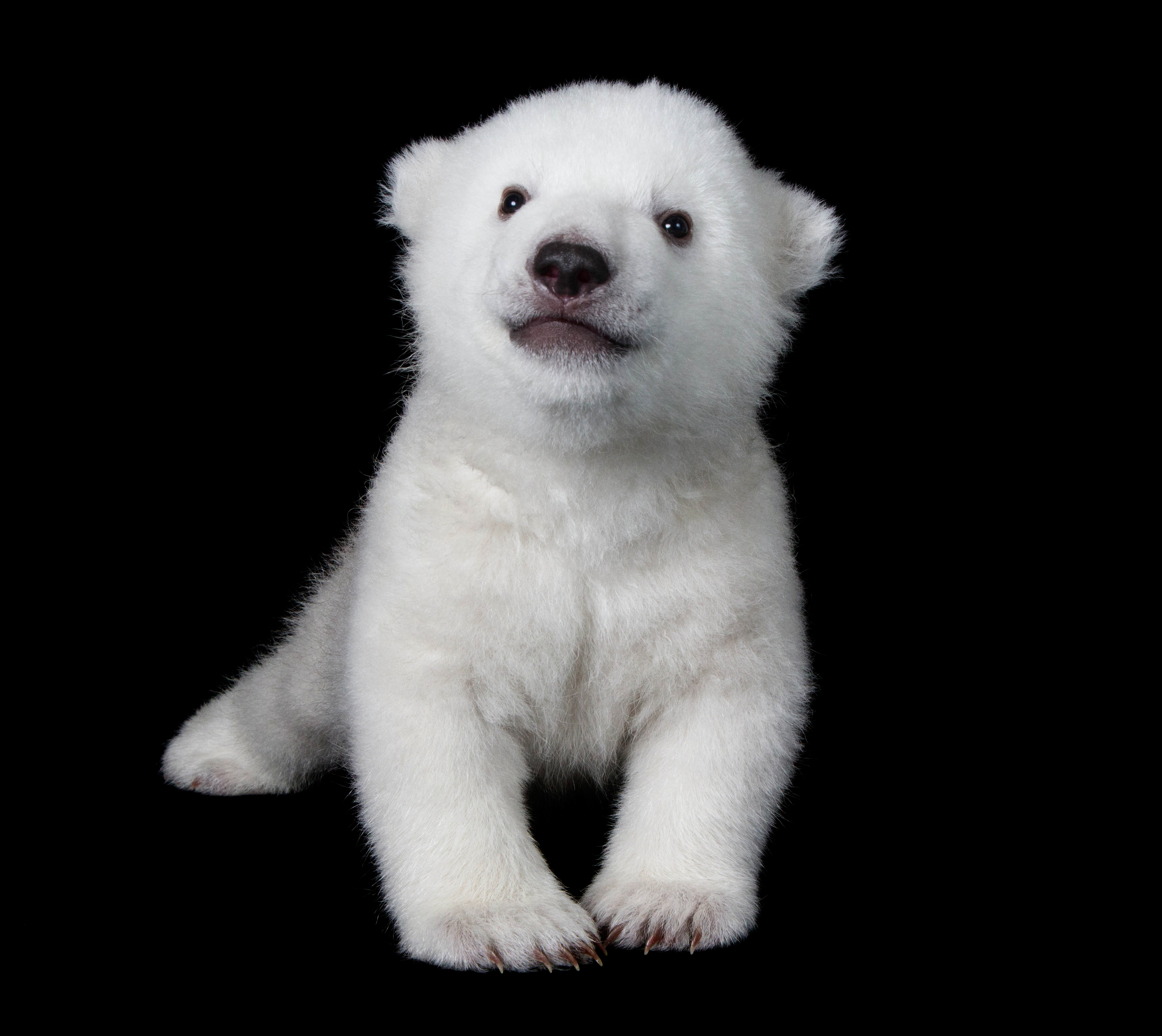
Luna at 2 months old. (photo: Buffalo Zoo/Kelly Brown)
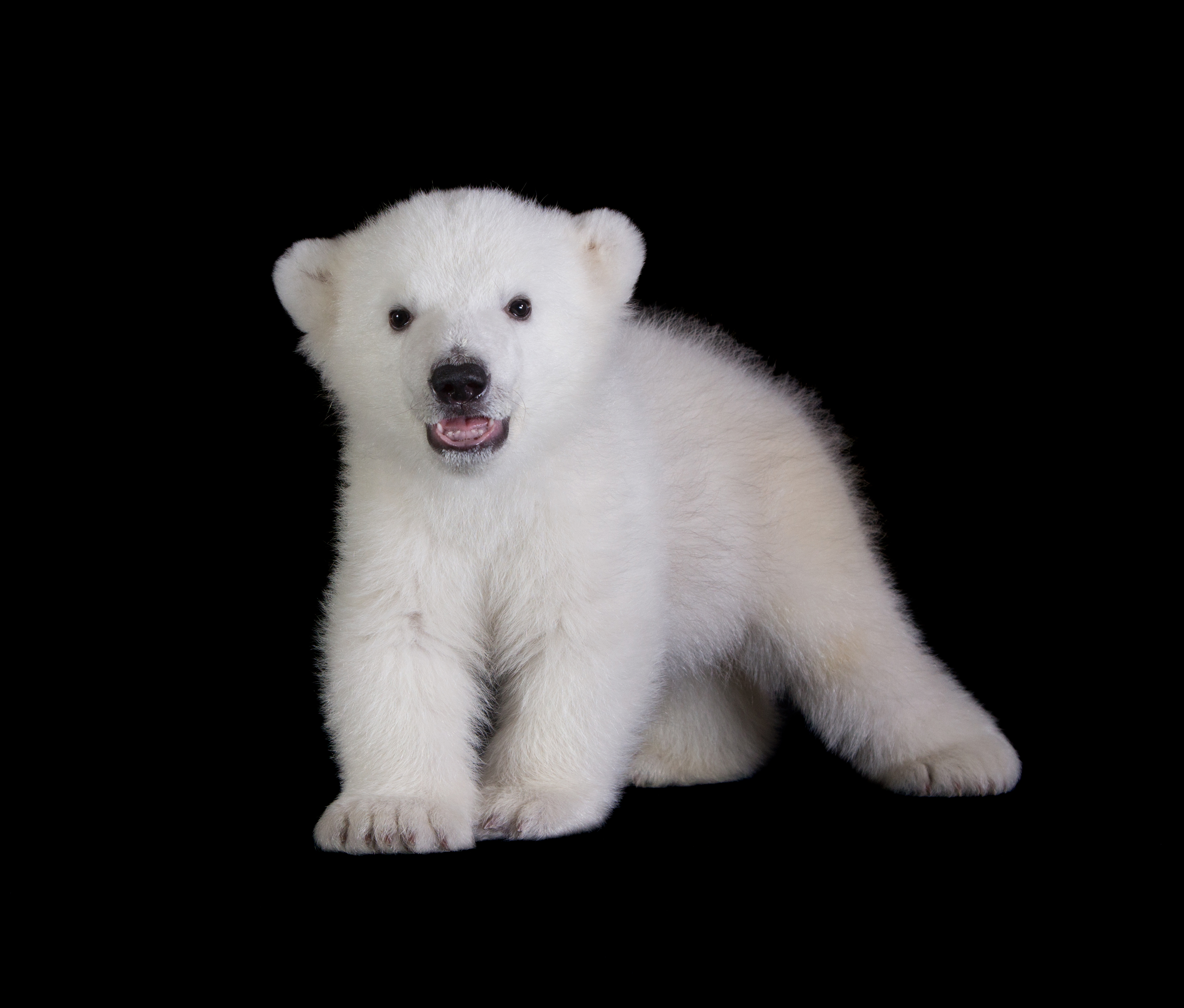
Luna at 3 months old. (photo: Buffalo Zoo/Kelly Brown)
In our situation we had cameras in the dens where the mother was and we were watching her constantly after she gave birth to see how she was treating the cub. She began to pace and hold it just by one paw, holding it incorrectly by its head and we just got really nervous about what we where witnessing. So we’ve been hand-rearing her for four months. We just got word that there's an orphan cub from Alaska that is similar age. He will be at the Alaska zoo for 30 days. And they have to basically watch him, and then depending on his development they’ll send him to Buffalo to join our female so they can sort of have playmates.
CURWOOD: And so what's his name?
FERNANDES: His name is Kali, spelled K-A-L-I, which is the name of the Inuit word for the city in Alaska where he was found.
CURWOOD: And what happened to his mom?
FERNANDES: His mother was shot. I'm not sure the circumstances, if it was someone defending themselves. There is a provision for local Inuit to collect so many, or hunt so many polar bears. I don't know the circumstances. All I know was that the mother was shot, that the bear was turned into Fish and Wildlife.
CURWOOD: So of all the zoos in North America who could've taken this orphan polar bear cub, why is he coming to Buffalo?
FERNANDES: It's exclusively because we have a similar aged cub. So he's just here for a number of months to socialize with our cub, but eventually he’ll be sent to one of the brand new facilities. So it’s really the importance of the peer-raising at this point for him.
CURWOOD: So now you’re going to be hand-rearing these two polar bear cubs. What do you have to have for a polar bear nursery school?
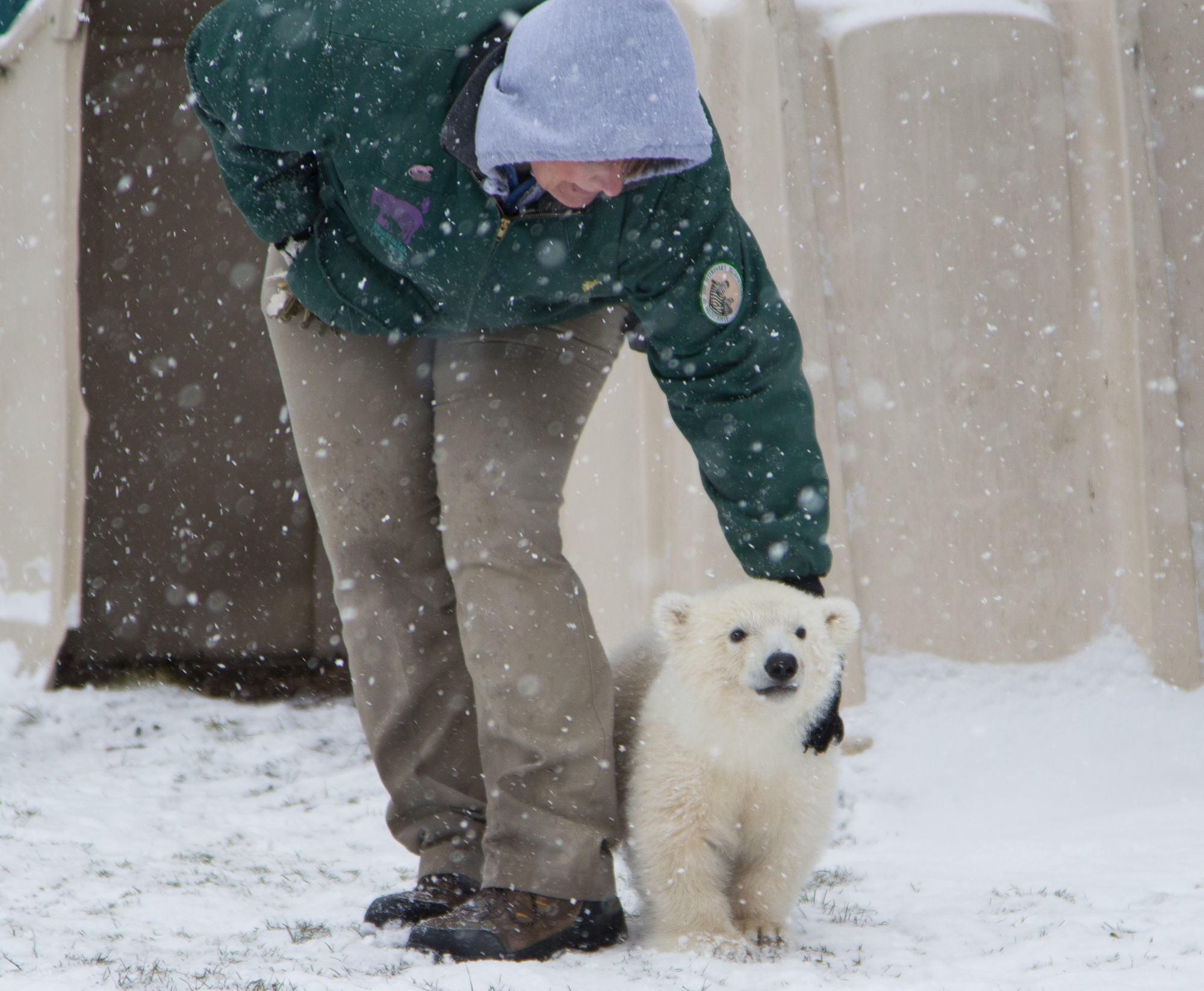
Luna and Alice Rochauer (photo: Buffalo Zoo/Kelly Brown)
FERNANDES: Mostly we have to teach them to swim and so we're exposing them to pools, negotiating different terrains. Initially, it's basically feeding them every hour and a half from a milk supplement and keeping the baby warm until they're able to thermo-regulate on their own. One of the big problems is, you don't want them to become too imprinted on humans, so having each other or peer-raising them will help so that they definitely learn bear-like behaviors. Because as they grow, they become obviously much more dangerous.
Luna, our cub’s claws have come in, her teeth are in so we do want to get her exercised and things, but having her chase around someone in an exhibit to get exercise now is a risk for that individual keeper, so the sooner we can get two similar aged playmates together they can do rough and tumble play, which is important for their development.
We also have to expose them to swimming. The pools we have picked out have areas that we can change the depth of the water, because ordinarily the female would supervise the swimming of her cubs and if they got into trouble she could retrieve them. But without having a mother in with them we have to make sure that they're in a safe pool situation at all times as they learn to negotiate different depths of water. So it’s just transitioning them to be more and more active in a more complex environment.
CURWOOD: So at some point obviously it's really not okay for a human to be in the same enclosure as a polar bear. At what point does that come, and how sad are you that you can't scratch them behind the ear and everything?

Luna with Veterinary Technician, Alice Rochauer (photo: Buffalo Zoo/Kelly Brown)
FERNANDES: Well, it happens sooner than you might think. She's four months now and she does, you know...if she bites you it's not like a little gentle play bite. It can really hurt. We are now moving to a practice of not spending time in with her, especially now that we can transition her into a full meat diet. So yes, I’m sure by six months but probably sooner than that we would have no one going in with her. By the time she six months, she supposed to weigh 60 to 70 pounds. So that's a pretty big animal, but mostly it's the claws and teeth that pose the risk.
CURWOOD: And of course she's on her way to weigh, what, 600 or 700 pounds?
FERNANDES: Eventually, yes, though Ananda, her mother, was sort of a petite female, so she may be a smaller bear, but she looks like her dad who was huge. So we think if she inherits her father’s size as well as good looks that she should be a big bear too.
CURWOOD: And then the boy polar bears, when they’ve grown up, they’re 1,200 pounds. They’re big.
FERNANDES: Right. Right. He weighs about half of what our cub weighs, so he's much smaller this point. I don't know if he's just a couple weeks younger or whether it really is reflective of the condition of his mother in the wild that may not have had the same level of energy resources to support him. And so he’s got a little catching up to do. But because the males are generally bigger, I'm sure he'll be putting on weight at the zoo in Alaska as well as when he gets here. He’ll making up the difference pretty quickly.
CURWOOD: How much do you think climate change is contributing to the increase in orphan polar bear cubs?
FERNANDES: It's the major factor right now. In Canada last year they ended up dispatching or terminating a number of polar bears that are just coming in, starving, or were near death. With global warming, if the sea ice melts earlier in the spring and forms later in the fall, it really reduces the total time that bears can hunt successfully, and so that will compromise female health. So whereas they always used to have twins, there's more singletons; higher mortality rates of cubs as well as much higher mortality rates of adults now.
CURWOOD: But I suppose, somewhat sadly, with what's going on with polar bears, you expect there will be more orphans all set for you to adopt.
FERNANDES: Yes, unfortunately that will be true, and we are designing so that we can accommodate future orphan cubs.
CURWOOD: So how much, Donna, do you think that seeing polar bears in captivity helps people understand the precarious situation that they’re in?
FERNANDES: We’re hoping it will be inspiring to them. I mean, she’s just so cute, the one we have, that everyone has just fallen in love with her. And if you just think imagine being the Canadian Fish and Wildlife [Service], or the US Fish and Wildlife [Service] and being forced to shoot these things because the sea ice is melting and there’s so many orphans out there.
So our exhibit experience ends with this messaging about things you can do at home. You know, simple changes in lifestyle - if we all made them - would totally reduce our carbon footprint significantly. So if it’s just using low energy appliances and compact fluorescent bulbs and commuting to work in a carpool or walking or biking or using other green technologies for energy - washing your clothes in cold water - a lot of simple things if everyone did it would make a huge difference.
CURWOOD: Donna Fernandes is the President of the Buffalo Zoo in New York State. Thank you so much, Donna.
FERNANDES: My pleasure.
CURWOOD: And if you can stand the cuteness, there are some pictures of Luna at our website, LOE.org.
Related links:
- Buffalo Zoo website
- Donna Fernandes staff page
- Polar Bears International, a polar bear conservation group
[MUSIC: Gabor Szabo “Ferris Wheel” from Dreams (Skye Records 1969)]
Hans Brinker with Briefcase
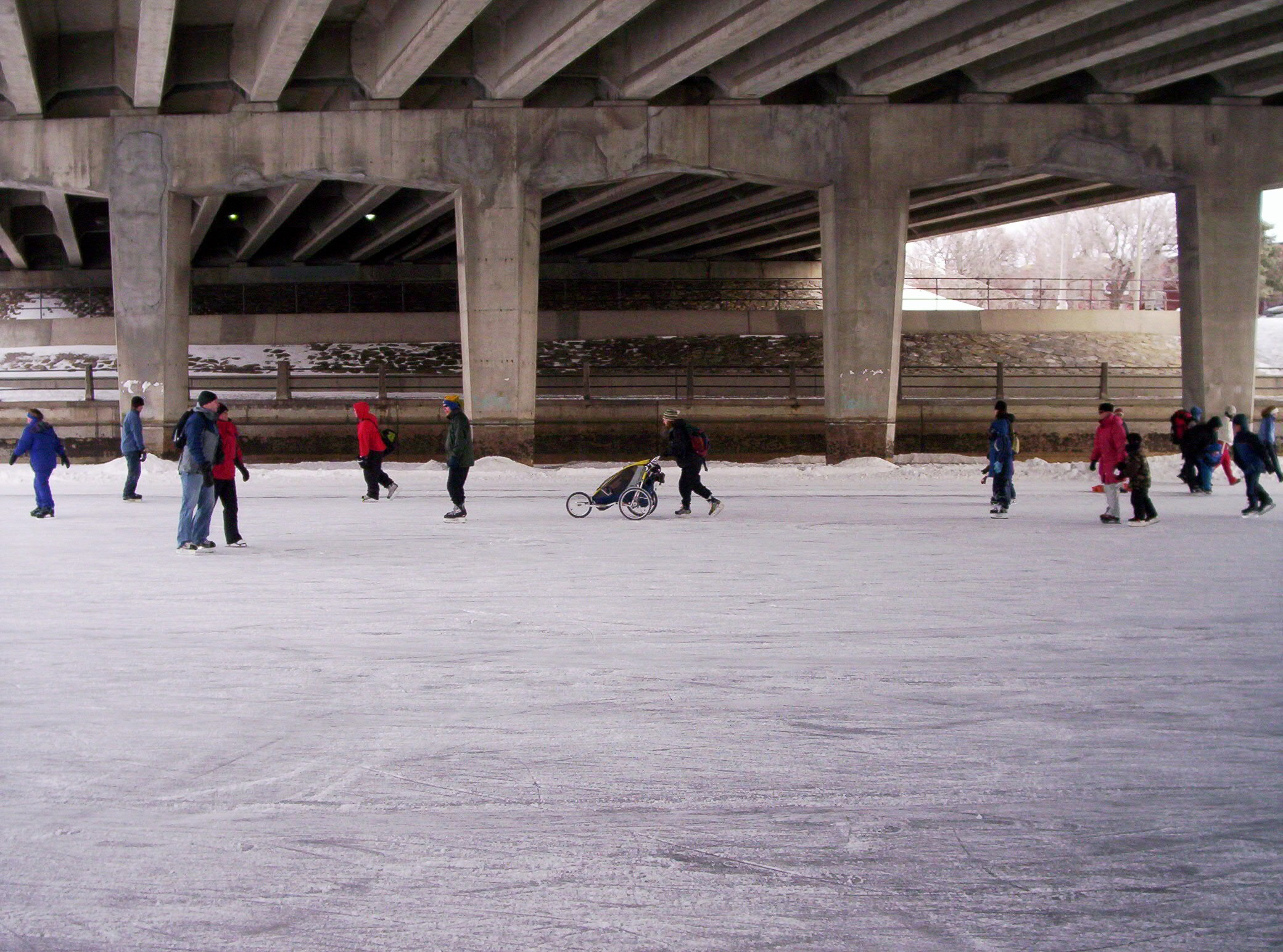
Winterlude Festival on the canal in Ottawa (photo: bigstockphoto.com)
CURWOOD: As we noted earlier in the show, North America is moving into Spring. And the warming weather means the end to a winter ritual up north - skating season on Ottawa's canals. As Bob Carty reports from the capital city of Canada, those canals can even create a healthy, eco-friendly way to get to work.
[TRAFFIC COMMUTE]
[RADIO ANNOUNCER: “CURRENTLY IN OTTAWA IT’S AROUND 16 DEGREES...]
CARTY: Rush hour in Ottawa on a cold March morning. So cold you have to scrape the frost off the inside of the car windows. So cold your tires have frozen flat on the bottom, and until they warm up you get a bumpy ride, what Canadians call having square tires. And then there's the slippery streets, the snow banks, and the slush.
[RADIO ANNOUNCER: “...AND ANOTHER ACCIDENT. WE’RE UP TO 6 NOW...”]
CARTY: In Ottawa, where winter is a five-month affair, there is at least an alternative to the morning madness of rush hour. Instead of the expressway, you can take the skateway.
[PHONE RINGS]
[RECORDED VOICE: “RIDEAU CANAL CONDITIONS AT 8:30 A.M. THE ICE SURFACE CONDITIONS ARE GOOD FROM THE NATIONAL ARTS CENTER TO PATTERSON CREEK...”]
[SKATES ON ICE]
MAN 1: Early in the morning, when the sun comes up, and there's hardly anybody on the canal and you can just hear your skates, it's about the only thing you can hear. It's wonderful.
WOMAN 1: I haven't skated for years. I skated when I was a kid, and it's great to be able to skate again, and it's just so much fun skating to work. I just think it's incredible. This frozen Rideau Canal is like a wonder of the world.
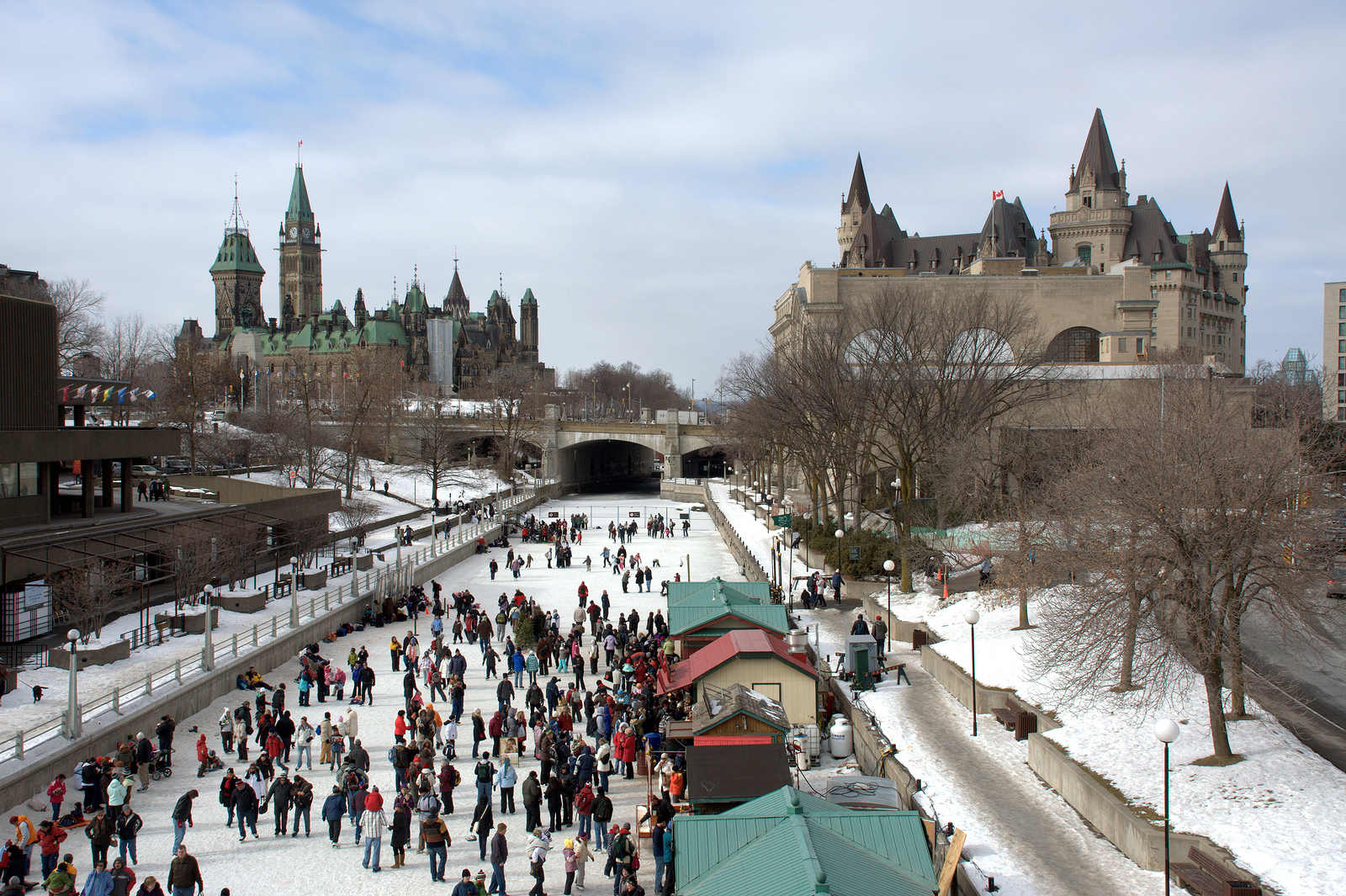
Winterlude Festival on the canal in Ottawa (photo: bigstockphoto.com)
CARTY: For two-and-a-half months, from late December to the usual mid-March thaw, an old canal running through Ottawa becomes the world's largest skating rink. It's 15 yards wide in most places. On one side students head south toward the University. On the other side, some neighbors and I are heading downtown with backpacks and briefcases. It's a three and a half mile commute for me, a 20-minute skate on a good day.
MAN 2: There's a few little bumps, but otherwise it's just really smooth and clear. The best part would be just at the beginning here, when you're sort of on the ice, just between the two walls of the canal.
WOMAN 2: What's interesting for me, being able to look at the sides of the canal, is that my ancestors were Irish stone masons who were brought over to work on the canal. The canal was built by Colonel By in 1832, and it was to give Canadians a route so they could avoid being ambushed by Americans on the St. Lawrence River. It's an amazing engineering feat.
CARTY: And there's another engineering feat just in keeping the skateway in operation every day. It takes 40 full-time employees, and a fleet of snow blowers, plows, and tractor-mounted sweepers, to clean off the snow and the ice shavings. Then, every other night, workers drill holes through the ice to pump up water to flood the surface. It's the equivalent of flooding 125 end-to-end hockey rinks. It takes eight hours. The result is a clean, smooth surface. Almost. You do have to watch out for the occasional rut. And the choice of skates is critical.
WOMAN 3: This took me a long time to get it straight about what kind of skates. I tried the new plastic molded skates that have velcro snaps, and they're supposed to be really quick to put on. But I hated the feel of them. Then I tried the traditional women's fancy skates with the picks. Didn't like them, and so I now am the proud owner of my first pair of men's hockey skates, and they're great.
CARTY: Hockey skates are my choice, too. Though the new fad on the skateway are speed skates, the ones with long 14-inch blades, worn by men and women in spandex outfits who torque by you as you're struggling against the headwind. [GASPS] Did I mention the wind? It can turn a pleasant, just below freezing temperature into a wind chill that feels like 15 degrees below zero. Doesn't seem to bother some skateway commuters, though I have a personal rule of thumb: If your nostril hair freezes in the first minute, maybe it's too cold to skate today, even if you do have the appropriate apparel, such as some or all of the following.
WOMAN 4: Scarves and a “tuc”, mitts, long underwear.
MAN 3: Fairly light shell jacket and a sweater. Shirt and tie. And the trick is not to get too sweaty on the way to work.
WOMAN 5: I, for one, need knee pads. [LAUGHS] As you can see, I got on a really ugly hat that keeps me warm. And you need Kleenex in your pocket.
WOMAN 6: You need to have Kleenex in your pocket for two reasons. One, you need to be able to blow your nose, because it gets cold and then you go into the warmth. The second reason is to wipe off your skate blades when you're finished.
[CHILDREN TALKING, SKATING]
CARTY: After the morning rush hour, the skateway is taken over by others - children and their teachers on a school outing, pairs of mothers, on skates, pushing strollers, reckless teenagers bobbing in between tentative tourists who are trying not to break any bones.
[SKATES SWOOSHING]
CARTY: Although the skateway costs $300,000 a year to operate, it pays off by attracting almost a million tourists every winter.
WOMAN 7: The amazing thing is, on a beautiful Saturday or Sunday, to see thousands and thousands of people on this canal walking, pushing their kids in these little sleighs. And you see people who are new to Canada, who are valiantly trying to skate and kind of staggering along, and it's great.
[SKATING ON ICE]
CARTY: At the end of the day, the commuters reappear on the skateway, a bit rubbery in the legs. Which sometimes requires a brief stop for rest and refreshment at one of the outdoor eateries on the canal.
CLERK AT COUNTER: How are you? What can I get for you?
CUSTOMER: One orange juice, one hot chocolate, and a famous beaver tail.
CARTY: Yes, you heard it right. He ordered a beaver tail. What exactly is a beaver tail?
CUSTOMER 2: It's really a flat, long dough-like pastry thing, and this one has garlic butter and cheese on it, so it's almost like a mini-pizza. But you can get just plain cinnamon and sugar, and even if you want some jams on top, you can do that, too.
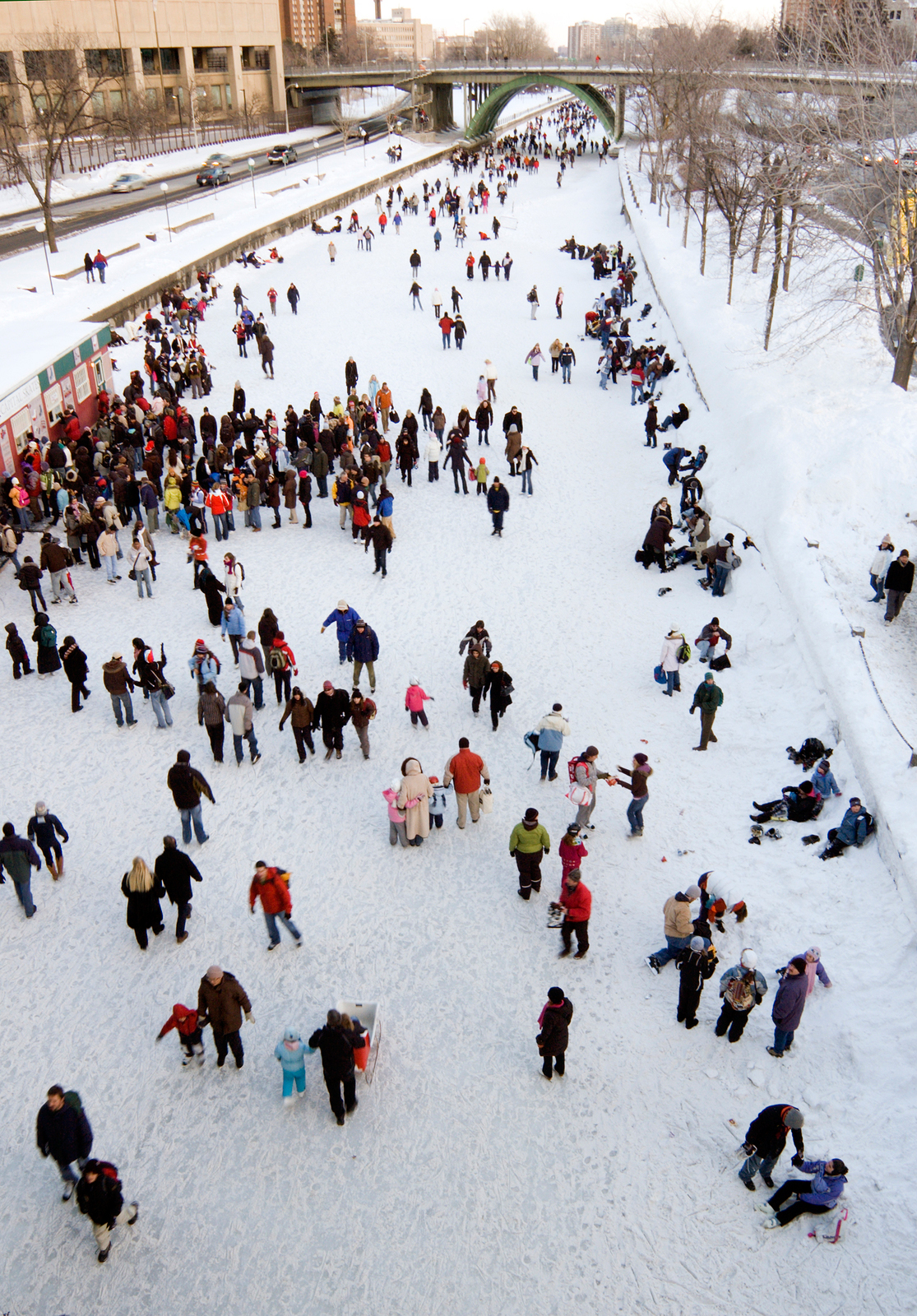
Ottawa skaters (photo: bigstockphoto.com)
[SKATES ON ICE]
CARTY: Recharged and refreshed, the final mile home is like skating downhill. The wind is gone. The stars are coming out. Skateway commuters can give you sound ecological arguments for doing this: it saves fossil fuels, it reduces pollution, it lessens the risk of climate change. But frankly, the real reason is that it just feels good. As one 7-year-old put it, you don't have to go around in circles. It's fun to skate straight. For Living on Earth, I'm Bob Carty skating straight on the Rideau Canal in Ottawa, Canada.
Related links:
- Bob Carty’s journalist profile
- More about Bob Carty and his music
- Website for the Ottawa Canal
[MUSIC: Paul Winter “Wolf Eyes” from Common ground (A&M Records 1977)]
[PACK OF WOLVES HOWLING]
CURWOOD: We leave you this week in the company of wolves. The calls of a large pack of Timberwolves and their pups echo through a pine forest. Timberwolves are a subspecies of the Gray wolf. They're large wolves that live in packs of up to 20 individuals. These wolves were recorded by Brian Wright for the International Wolf Center CD, Timberwolf in the Tall Pines.
[MUSIC: Timberwolf In The Tall Pines (Rykodisc 1990)]
CURWOOD: Living on Earth is produced by the World Media Foundation. Naomi Arenberg, Bobby Bascomb, Emmett Fitzgerald, Qainat Khan, Helen Palmer, Adelaide Chen, James Curwood, Jennifer Marquis and Gabriela Romanow all help to make our show. Jeff Turton is our technical director. Alison Lirish Dean composed our themes. You can find us anytime at L-O-E dot org. And check out our Facebook page - it’s PRI’s Living on Earth. And we tweet from @livingonearth. I'm Steve Curwood. Thanks for listening!
ANNOUNCER: Funding for Living on Earth comes from Stonyfield Farm, makers of organic yogurt, smoothies, and more. Stonyfield invites you to just eat organic for a day. Details at justeatorganic. com. Support also comes from you our listeners. The Go Forward Fund and The Town Creek Foundation.
ANNOUNCER 2: PRI Public Radio International.
Living on Earth wants to hear from you!
Living on Earth
62 Calef Highway, Suite 212
Lee, NH 03861
Telephone: 617-287-4121
E-mail: comments@loe.org
Newsletter [Click here]
Donate to Living on Earth!
Living on Earth is an independent media program and relies entirely on contributions from listeners and institutions supporting public service. Please donate now to preserve an independent environmental voice.
NewsletterLiving on Earth offers a weekly delivery of the show's rundown to your mailbox. Sign up for our newsletter today!
 Sailors For The Sea: Be the change you want to sea.
Sailors For The Sea: Be the change you want to sea.
 The Grantham Foundation for the Protection of the Environment: Committed to protecting and improving the health of the global environment.
The Grantham Foundation for the Protection of the Environment: Committed to protecting and improving the health of the global environment.
 Contribute to Living on Earth and receive, as our gift to you, an archival print of one of Mark Seth Lender's extraordinary wildlife photographs. Follow the link to see Mark's current collection of photographs.
Contribute to Living on Earth and receive, as our gift to you, an archival print of one of Mark Seth Lender's extraordinary wildlife photographs. Follow the link to see Mark's current collection of photographs.
 Buy a signed copy of Mark Seth Lender's book Smeagull the Seagull & support Living on Earth
Buy a signed copy of Mark Seth Lender's book Smeagull the Seagull & support Living on Earth

